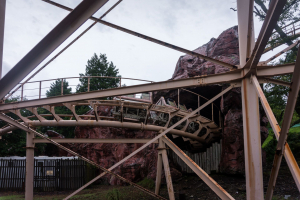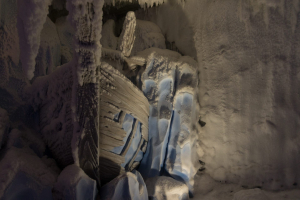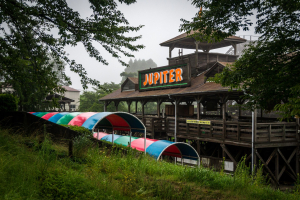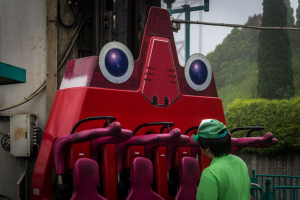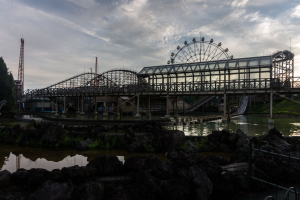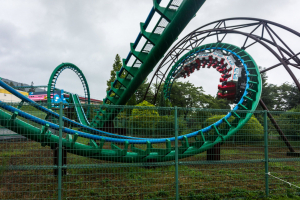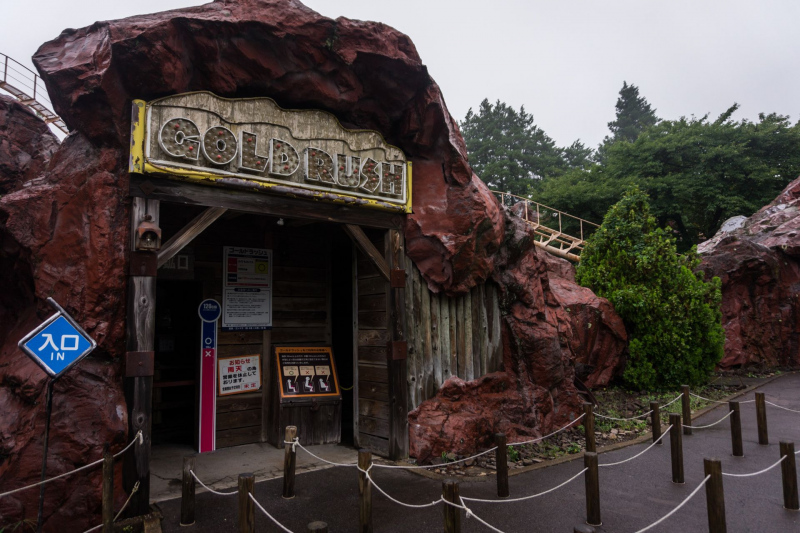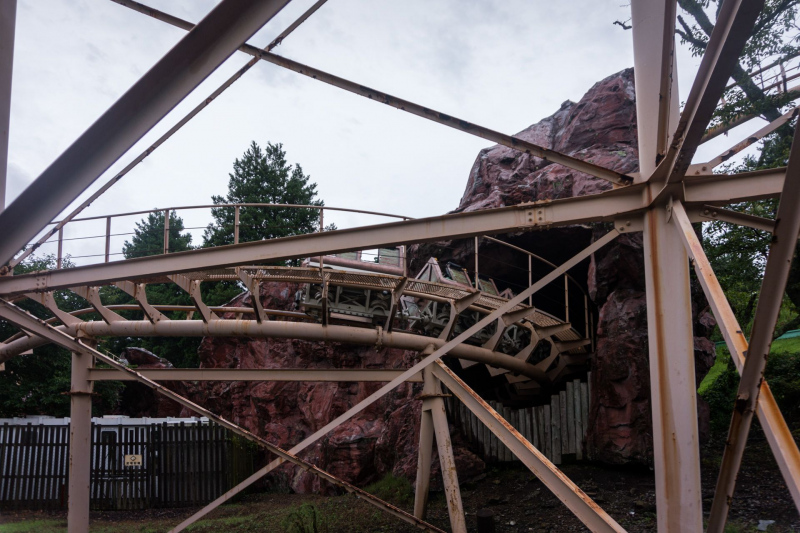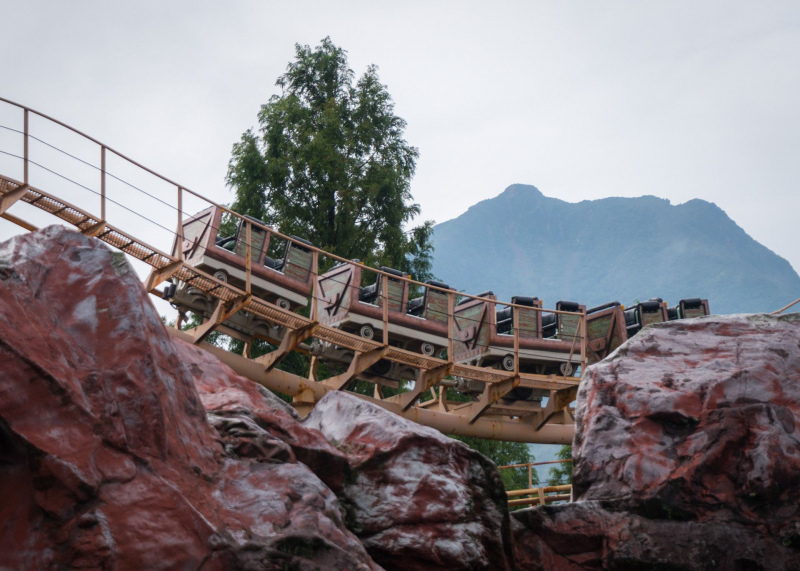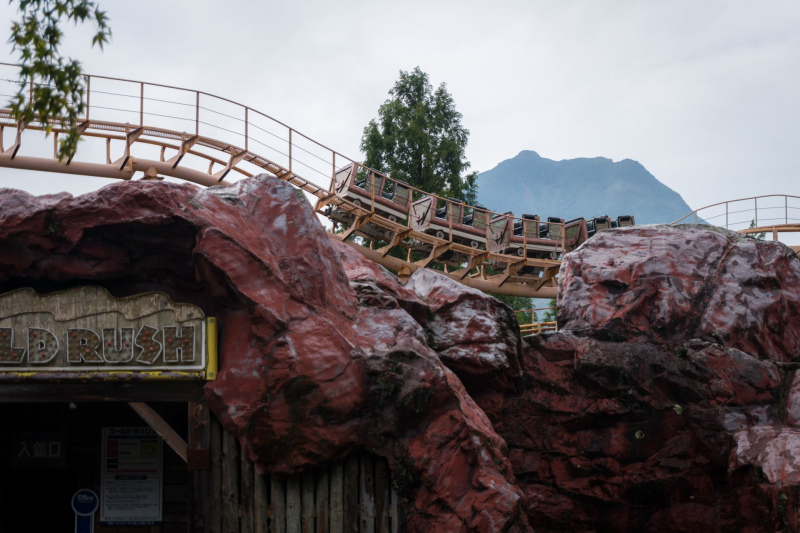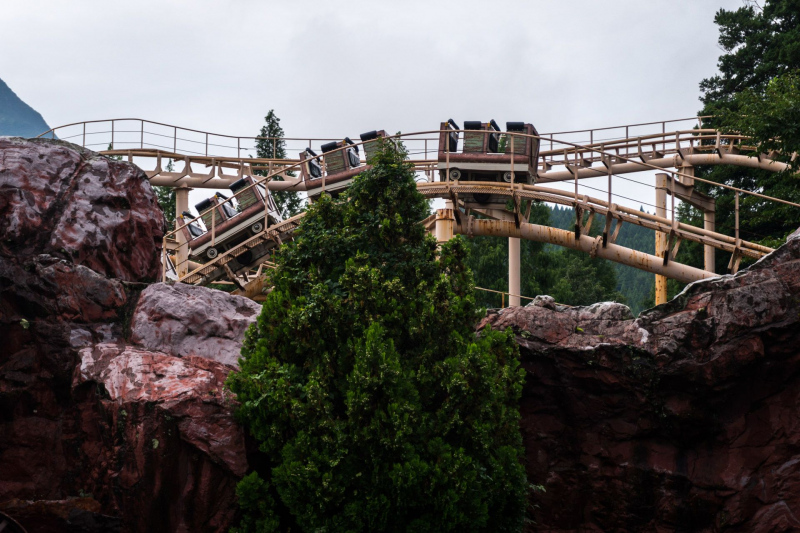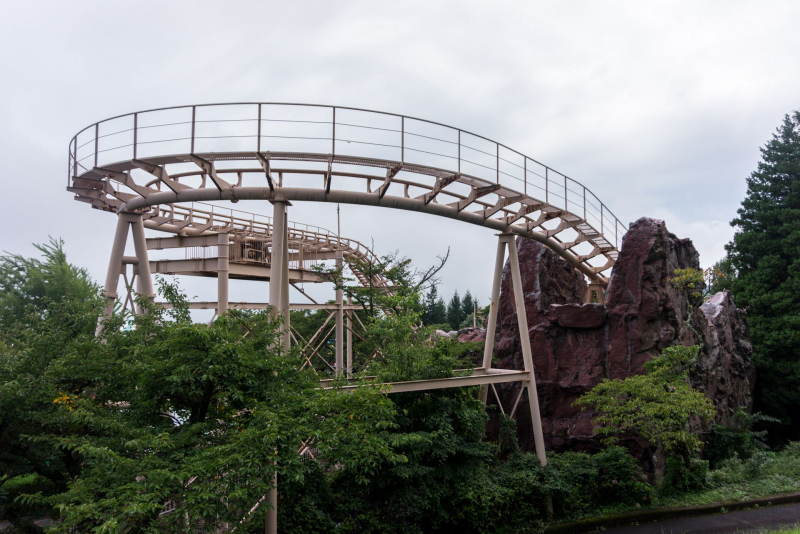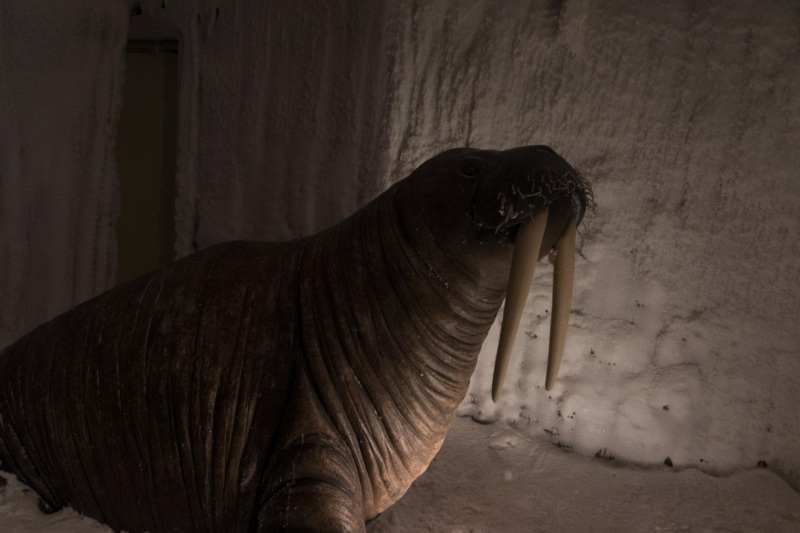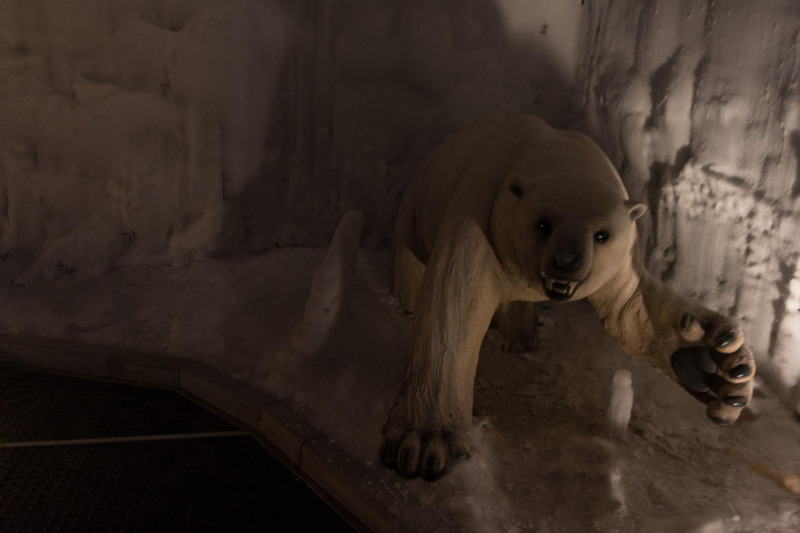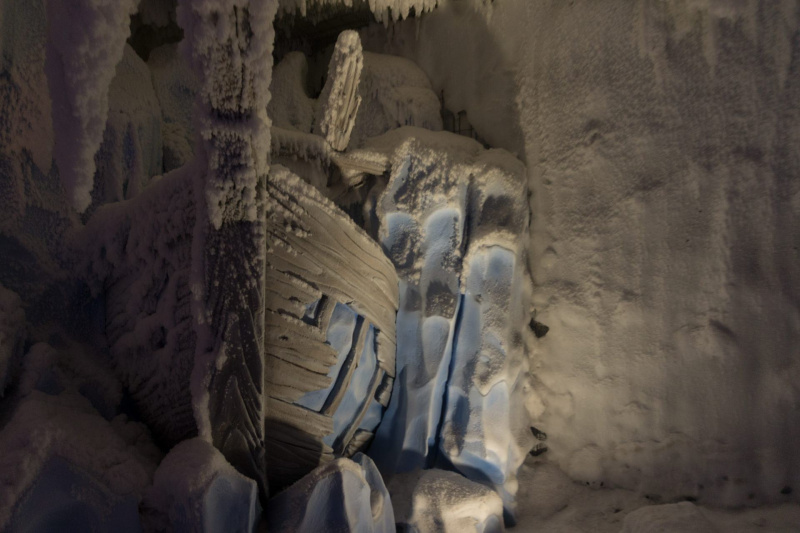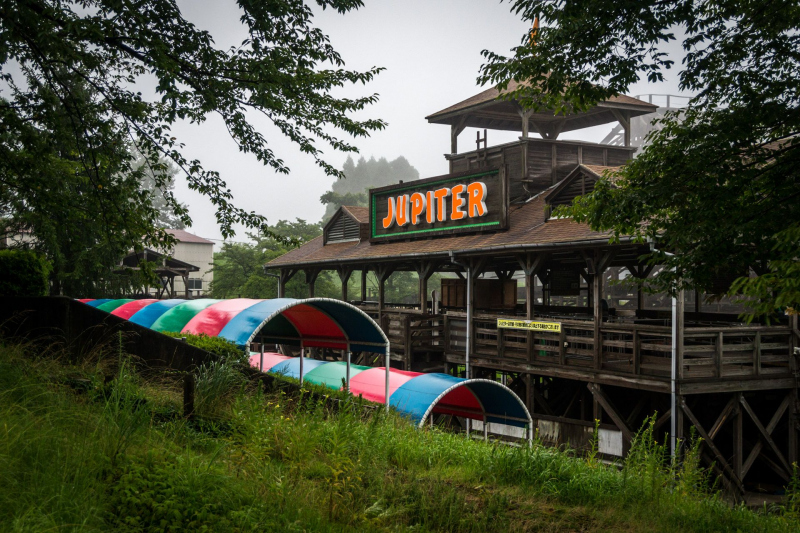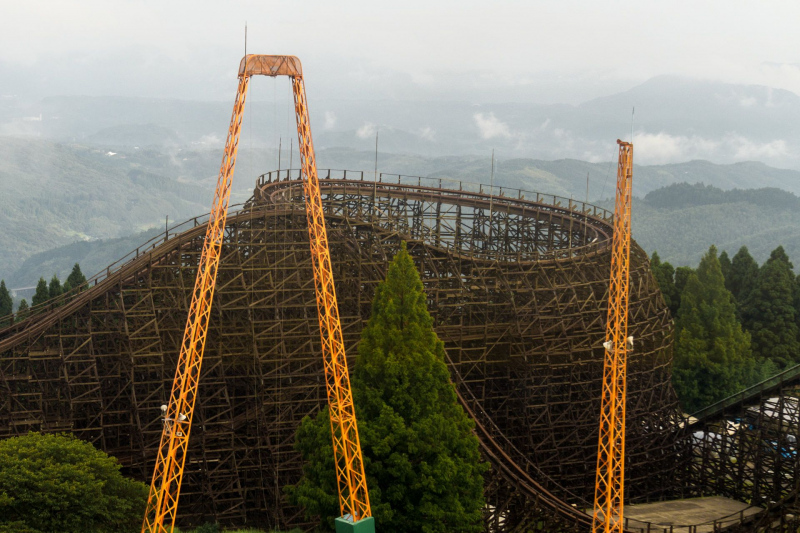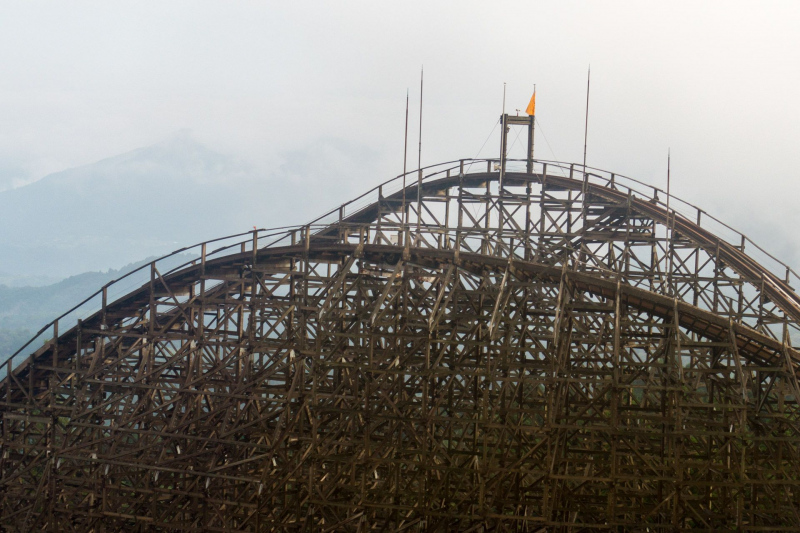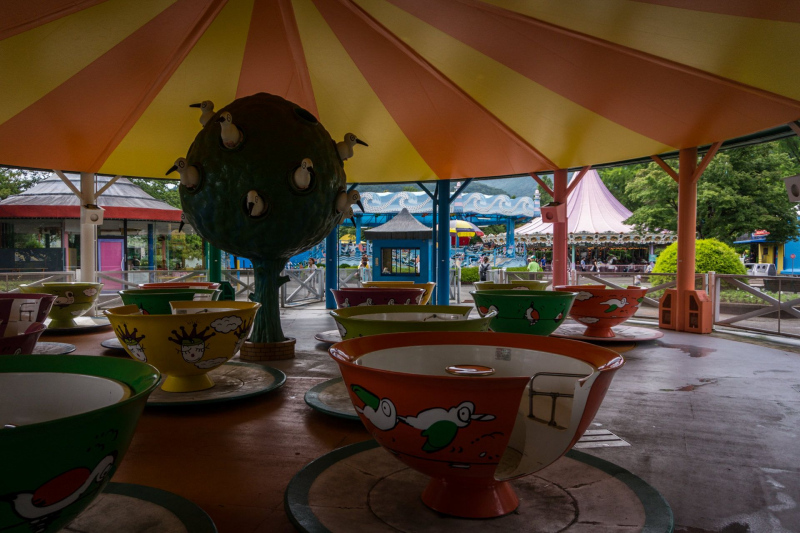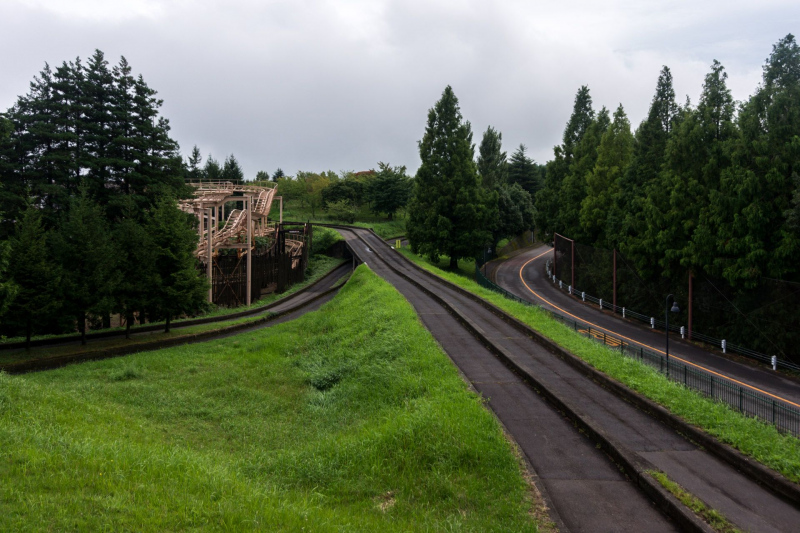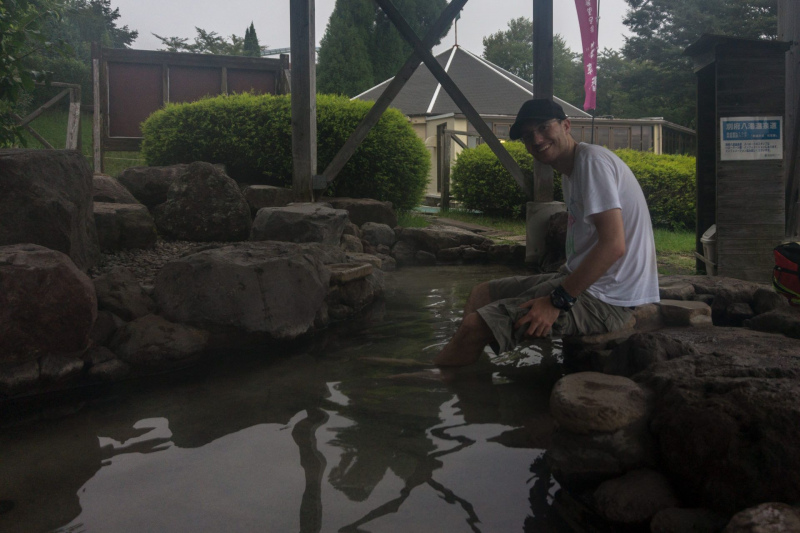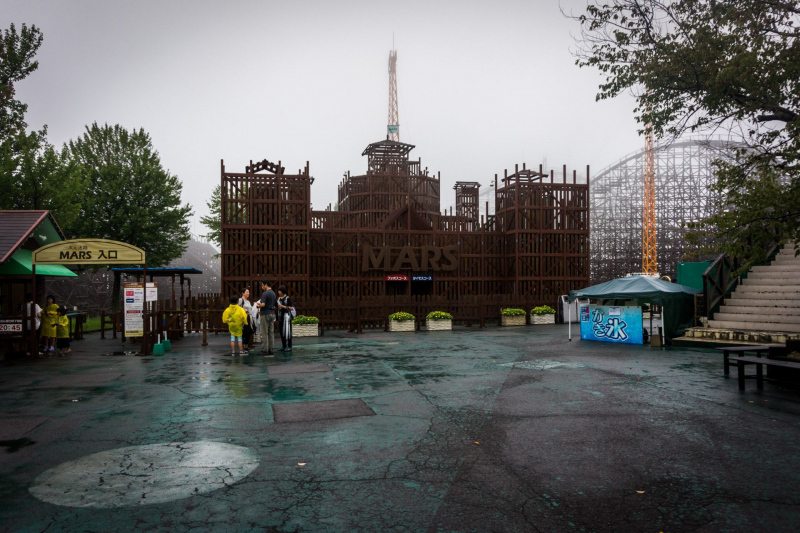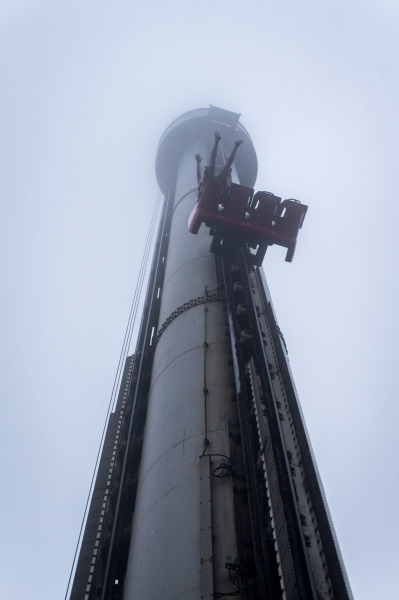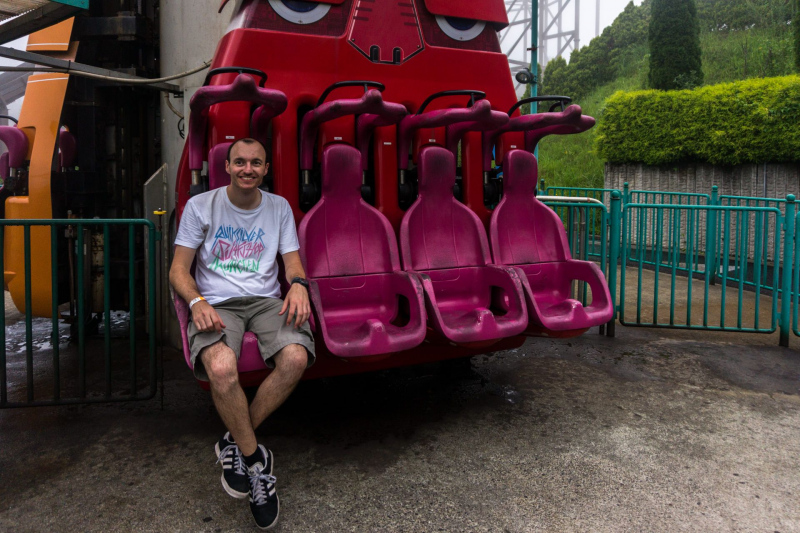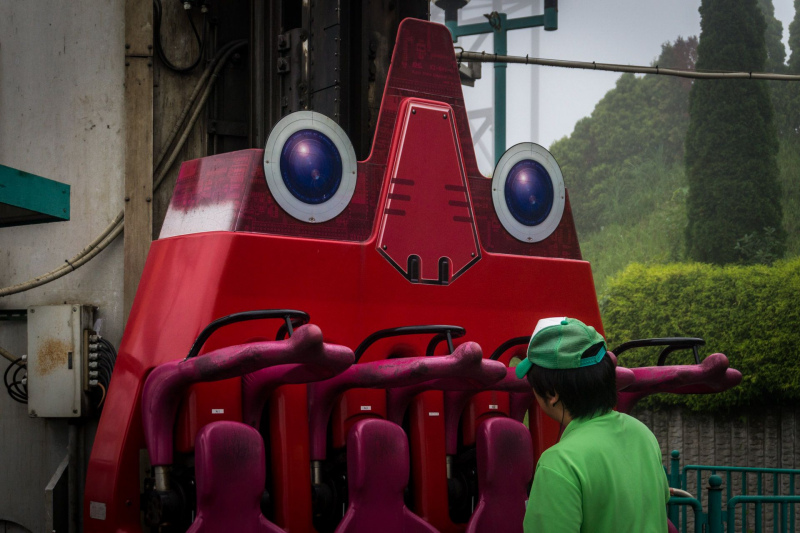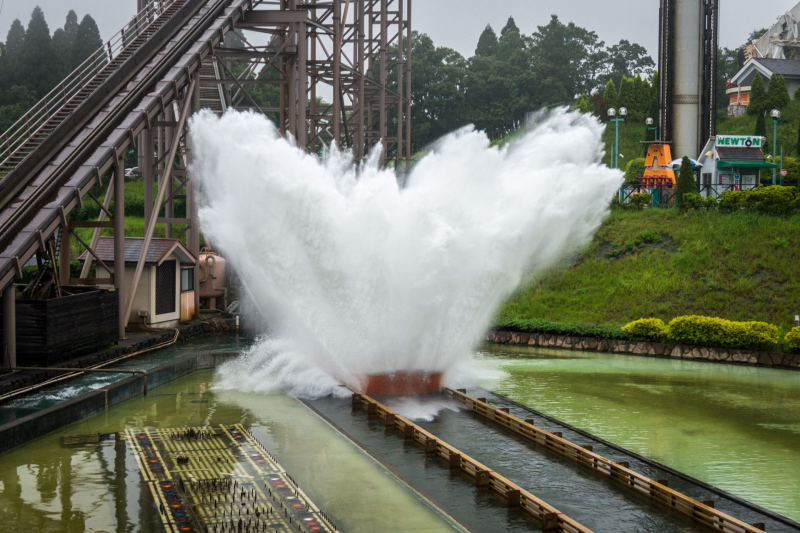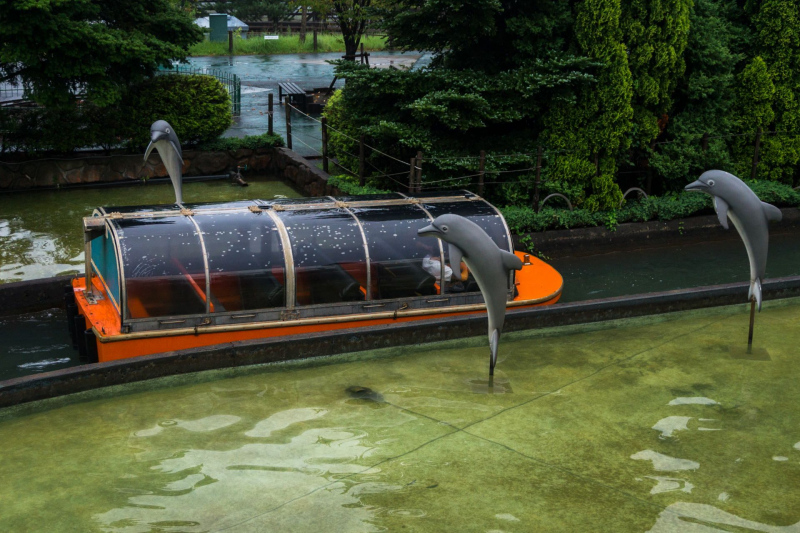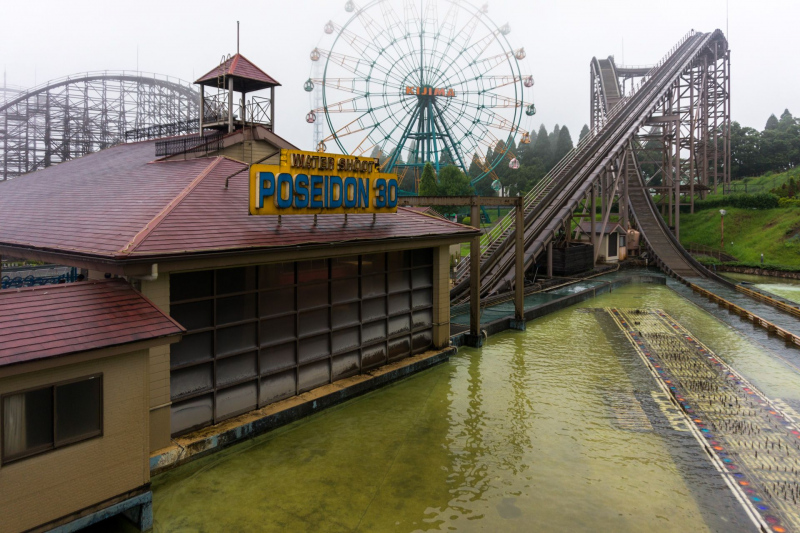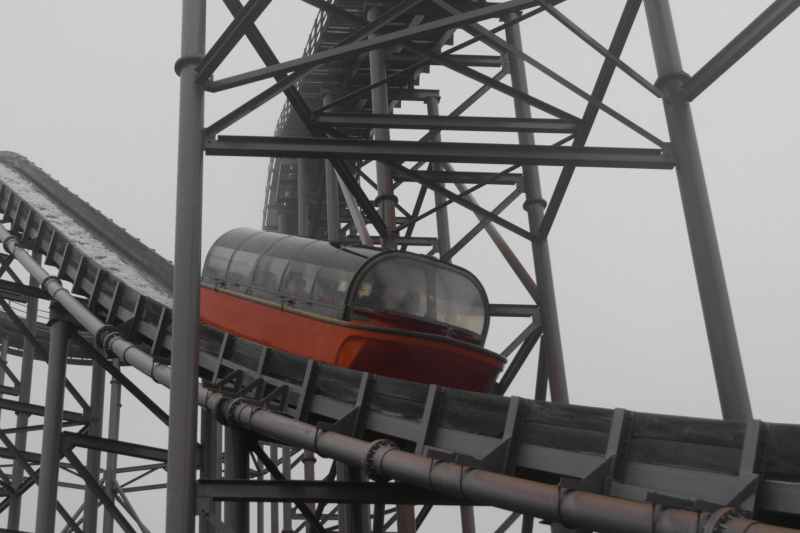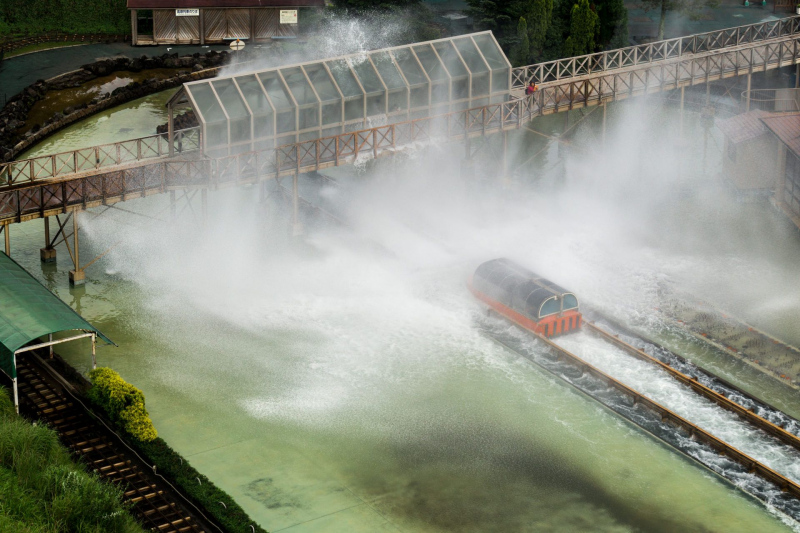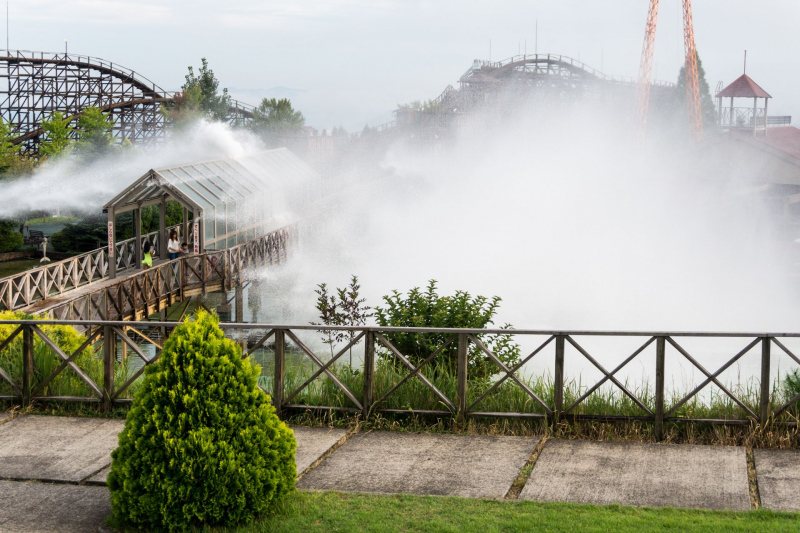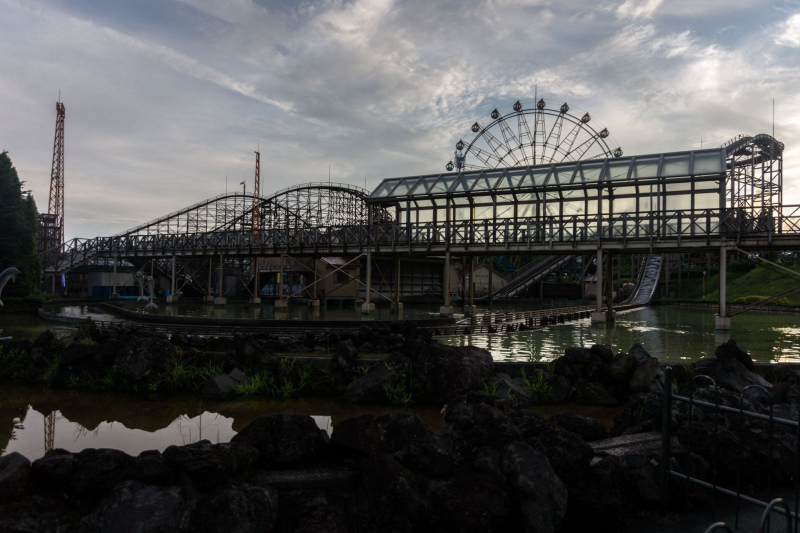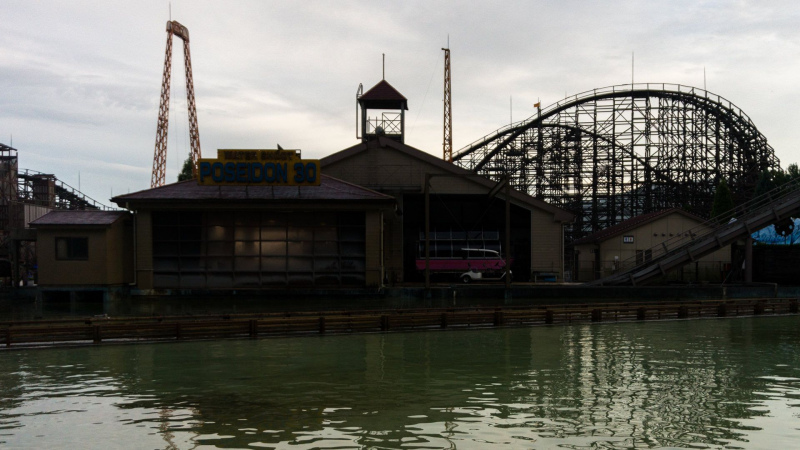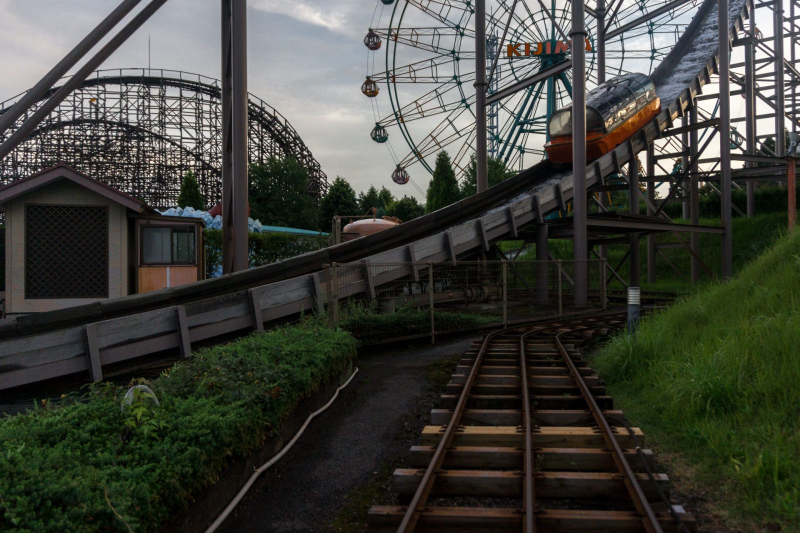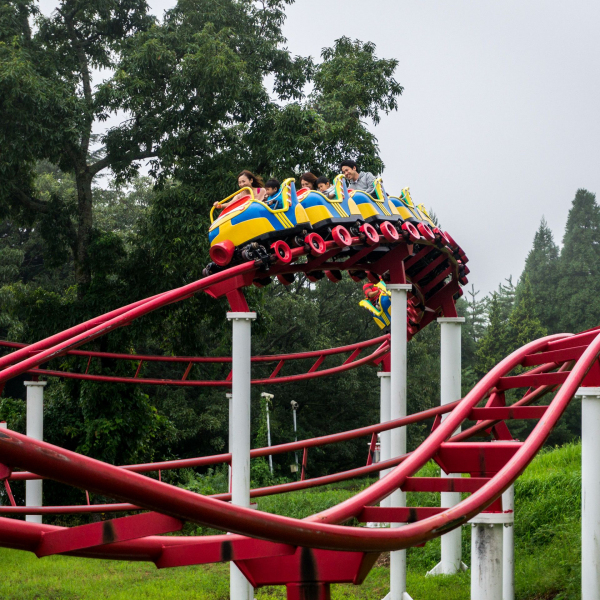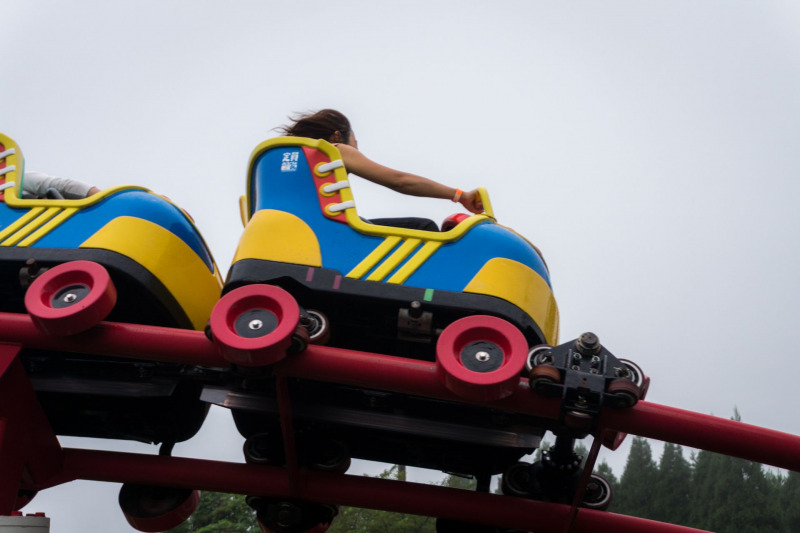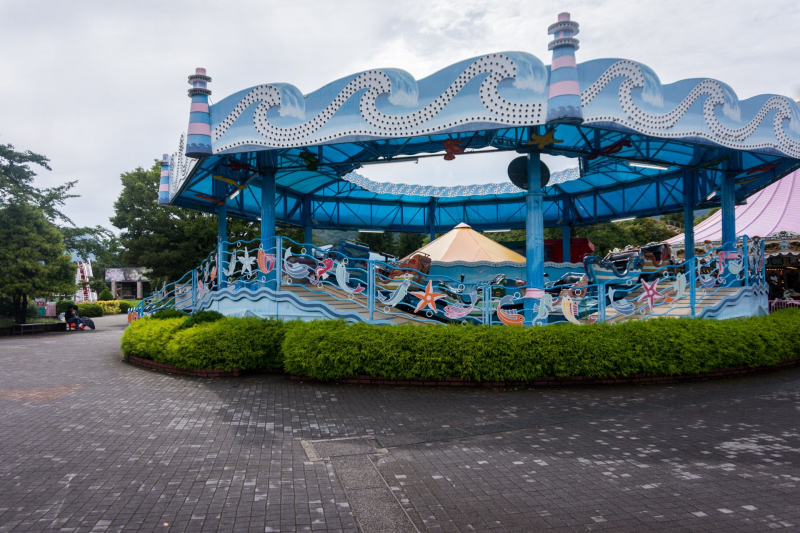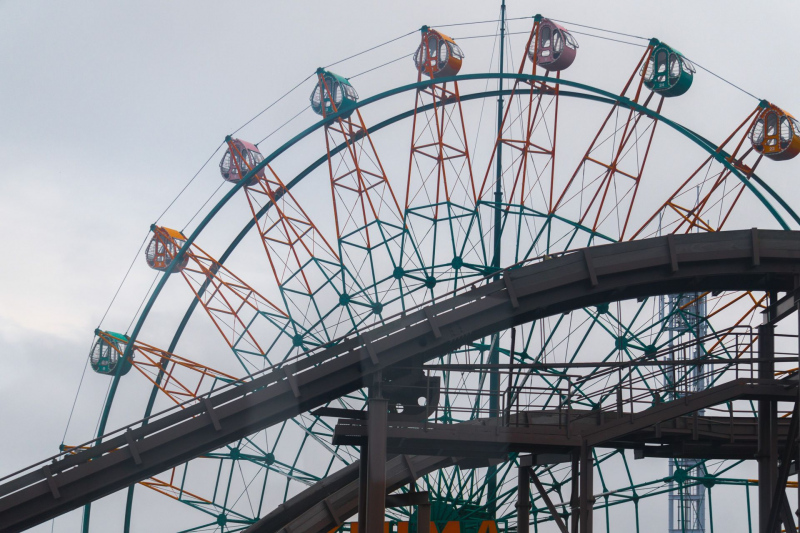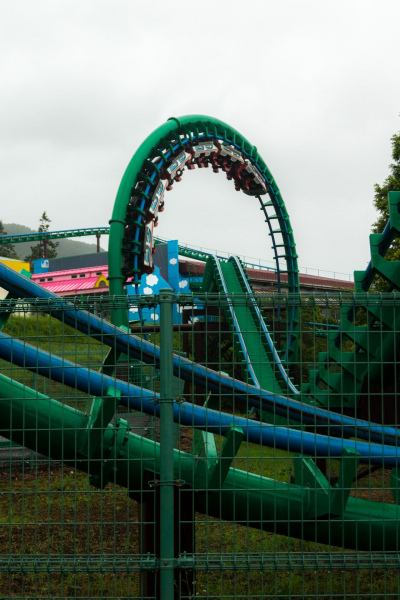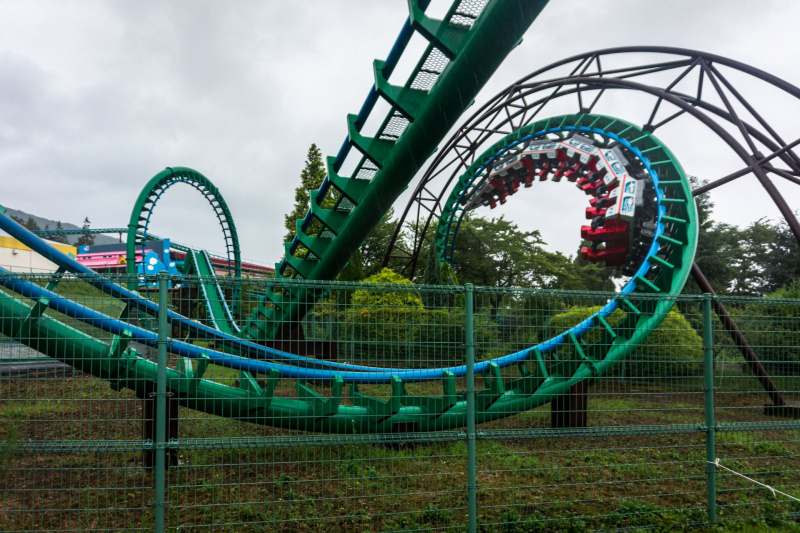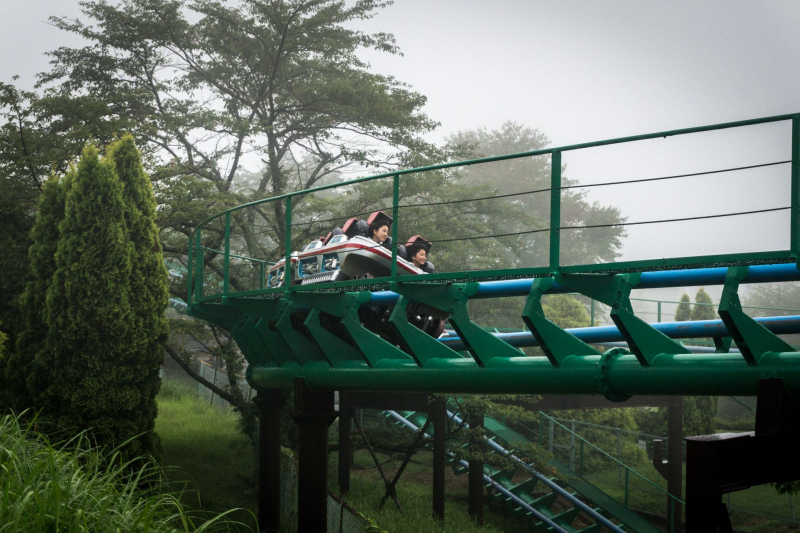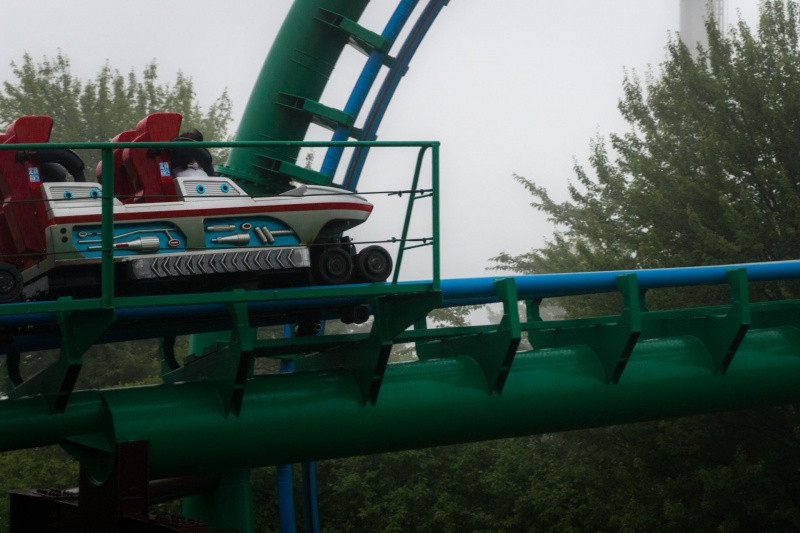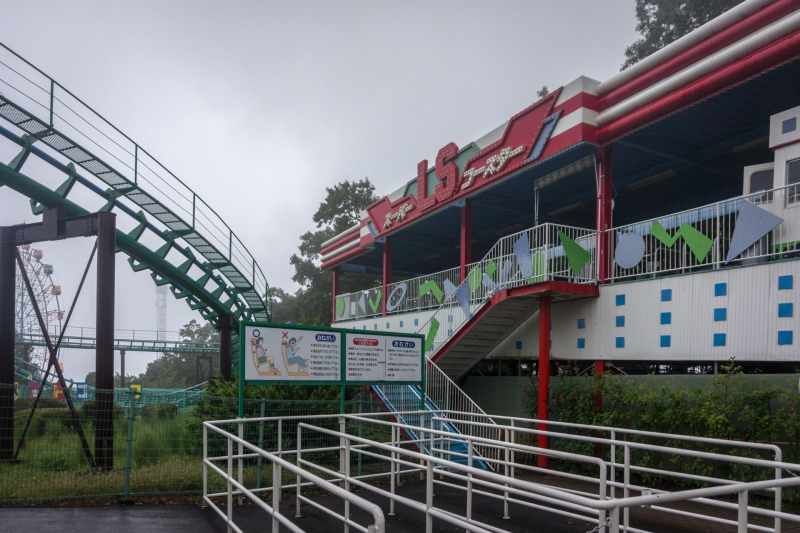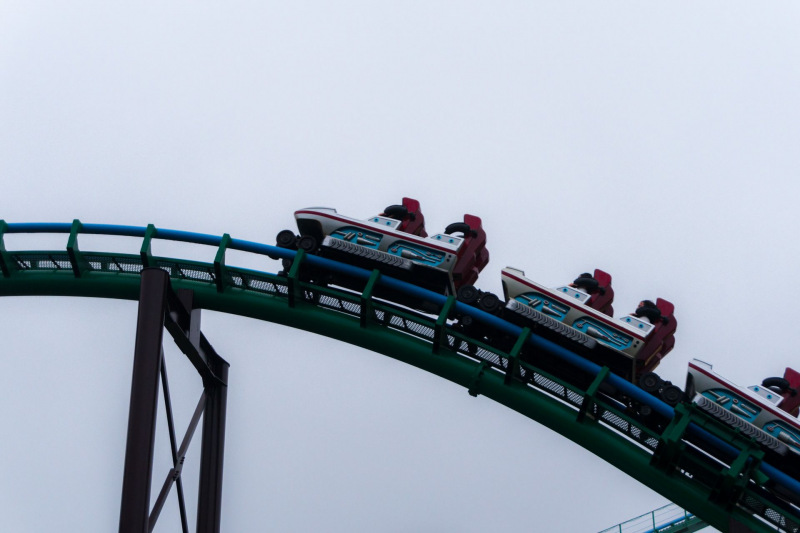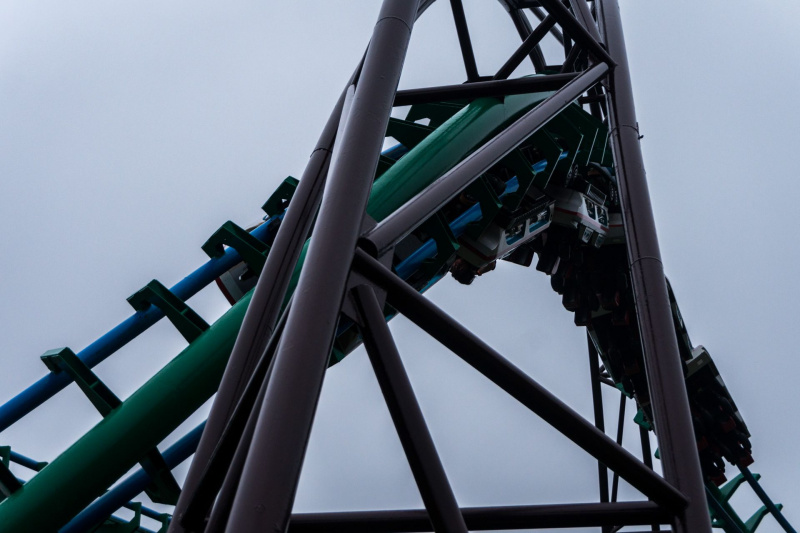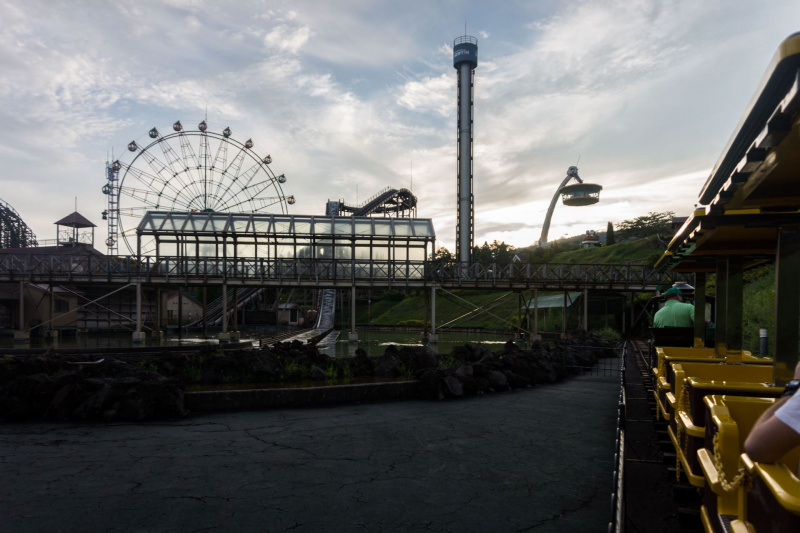Greenland
The Greenland Resort has been located in the middle of the Japanese coal-mining area since 1964. Once founded by the Mitsui Mining company as a subsidiary, the holiday resort has been repositioned again and again over the course of time and, after the Mitsui Group left, is now operated solely as Greenland (i.e. without the prefix Mitsui). In addition to the eponymous theme park, the resort consists of two hotels, a golf course, a bowling centre, a pachinko hall, several restaurants and the obligatory hot spring.
The gigantic Ferris wheel already catches everyone’s eye on the way in, but when the first roller coasters join them, it’s a picture that makes your mouth water. So we hurry up to the entrance to pay the entrance fee and the free pass at the cash desk. You then exchange the voucher for the Free Pass in Greenland for the corresponding wristband for permanent rides – alternatively, as in most Japanese theme parks, you can pay for the rides individually. Greenland is therefore a classic Tivoli park, but it has more parallels with the world’s oldest amusement park, the Bakken in Copenhagen, Denmark.
Milky Way
We start our tour counter-clockwise, but immediately turn away from the Grampus Jet and Ladybird Coaster, which are very busy in the morning, and walk at a brisk pace to a very special double attraction, which takes us on a lively trip through the Milky Way, either standing up or sitting down.
Early in the morning, we were spoilt for choice on Milky Way between the Altair stand-up coaster (the blue side) and the Vega sit-down variant (the pink track). However, as boarding for Vega was just starting, the first ride was to be on this ride. As soon as both trains have been dispatched, the journey can start immediately.
The first step is the classic chain lift to a starting height of 38m. At the top, there is a leisurely right turn before the madness takes over. Parallel to the stand-up track, you now shoot towards the abyss, which really gets you out of your seat. While Altair says goodbye to us in a right turn, we race over an airtime hill and immediately over a slightly inclined turn. But we don’t have to wait long for Altair, because the train is already coming towards us on the exit. After we have taken enough of a run-up, the train tries to throw us off on the next airtime hill without any consideration. But a highlight rarely comes alone and after Togo has already proven that they are the kings of negative forces here, the same applies in the positive direction. With proper pressure on the body, one now performs a downward helix to the lowest point of the layout. From there, a slightly inclined ramp leads back up to the station level, but not without being briefly lifted out of the seat once more. After the short duel, Altair joins us again and parallel to each other, there is a short left turn and a small hill before we reach the braking section and, after a short turn, the station.
If Vega already sounds so good, I’d best tell you what the rascal from Altair is up to, shall I?! All right, after we have moved towards the ground with only slight airtime and said goodbye to Vega, we now also pass a rather high airtime hill and take off in a familiar manner; however, the subsequent downward helix is just as delicious. With a lot of pressure on your feet, you leave the helix on a short ramp, which immediately turns into the turning curve just below the turning curve of Vega. Here, the train of the sister track comes towards us in a grandiose moment of pure (riding) joy. With much more pressure than Vega, we pass through the forest of supports of the turning curve before we are mercilessly transported into the shoulder restraints in the most insane airtime moment of all time. With what feels like 20 cm of free space, measured it could even be a little more, between the foot and the train floor, you fly over a tiny little hill before going up another hill. At the top, you have a short breather, but your head is rather in the process of correctly classifying what you have just experienced by taking a short left turn to end up parallel to the sister track again. The aforementioned left-hand bend follows, followed by a combination of small hills and block brakes, which comes along leisurely, but in the end can’t help but knock your socks off again.
In the end, what else is left but to fall mercilessly in love with Togo? Both Milky Way tracks are simply wonderful to ride. There are outstanding airtime moments, just as there are extremely punchy passages. On top of that, Vega’s train is also an oversized Bluetooth speaker – what more could a roller coaster fan want? Probably a buttery smooth ride and a non-existent waiting time? Don’t worry, the Greenland has thought of that too, although at least the second point was a bit of a downfall and later in the day we only had the Vega sit-down pearl at our disposal.
Danger in a Maze
Well, you know what I mean and so far we’ve only covered one ride, so let’s move on: The next attraction on our tour is the interactive maze Danger in a Maze, where you have to stop a bomb at the last second. The circuit is very straight forward, even if it means you have to wait a little longer at a door. The design of the ride is exactly the same on the inside as it is on the outside, making it an absolute must-do.
Splash
Also in this category, with outside temperatures well over 30°C and sultriness present, is the splashy water ride Splash. Now some people will think to themselves “hmmm, I know this generic name from somewhere” and they will be amazed that they have also seen the design of the ride before. One could even assume a common park friendship between the Dutch amusement park Duinrell and the Greenland, after all the ride, in both cases built by O.D. Hopkins, already opened there in 1992 and the Greenland followed suit a year later.
Unlike the day before and Duinrell in general, however, there was no possibility of taking a seat in a covered boat here, but the wise Japanese had thought of everything and so there is the possibility of borrowing a rain poncho for the duration of the ride. But if you think this will cost you money, you’re wrong at Greenland, where you can even let off steam with the free pass at the individual game stalls; the emphasis here is actually on the rental, because after the ride you hand the rain poncho back in so that it can be dried by the staff. As a spillwater fan and generally environmentally conscious person, you have no choice but to thankfully do without the poncho, even if Greenland (and I would wish this of all other amusement parks) cuts out the revenue from the sale of the full-body condoms. When you meet the future passengers after the ride, refreshed and extremely wet, you are rewarded by the irritated and at the same time enthusiastic looks of the Japanese and may even high-five some of them; a wonderful feeling.
Sphinx Coaster
Although the Greenland is a huge amusement park, the distances to the next attraction are usually not so excessively far, so we ventured a ride on the Sphinx Coaster with a slight touch of wetness. This family roller coaster is characterised above all by its marginally existing gradients, which already make a simple Big Apple look very steep. But while the worm coasters are quite tame, the Japanese flat coaster builds up quite a high speed towards the end, which is conveyed amazingly well especially by the flat descents.
Panorama Mountain
Past the water park, where interestingly almost all the slides are designed for an adult audience, the Skylift cable car takes you up to Panorama Mountain. All safety mechanisms on the gondola are dispensed with. Additional padding on the roller coasters? Sure! But cable cars with safety bars? We Europeans sometimes tend to exaggerate when it comes to safety.
On Panorama Mountain, in addition to the Horror Tower, which tells a local horror story but is not very scary on the way through the two floors, there is the Witch’s Flying Chair chain carousel and the mountain station of the Super Slider summer toboggan run. Interestingly, it seems that luges are not very common in Japan, which is why the staff are happy to explain in great detail how the bobsleds work to the waiting passengers. It’s just a shame when these passengers listen but don’t really understand how to accelerate in the end. So I was allowed to spend most of the descent behind a lurker, while Nicolas joined us only towards the end of the ride.
Dragon Mountain and Spin Mouse
Back in the valley, the trail leads us towards the Reverchon Spin Mouse. Along the way we pass the Karakuri Castle Maze and the station of the suspended monorail Sky Ship before entering the Dragon Mountain rapid river. This was built by Bear Rides and, due to the non-existent degree of wetness, can unfortunately only score points through its embedding in the landscape.
Well, let’s get into this beloved old friend from France, which someone from Parques Reunidos will please take a closer look at – but I’m anticipating something here, so I’ll just explain what I mean. On the Spin Mouse, all the wagons are loaded at the same time, but then sent out on the track at a fast pace. What in Spain, however, quickly leads to a waiting time beyond 90 minutes with a normal mouse (Vértigo in the Parque de Atracciones de Madrid), is quickly resolved within three to four cycles here. The real difference lies in the efficiency of the Japanese staff, not in the theoretical capacity of the ride, which is roughly the same in both cases. The ride was also extremely fast-paced and thus thoroughly entertaining.
Legend of Salamander
Passing the go-kart track, we are now drawn to the north entrance of Greenland, near which the interactive dark ride Legend of Salamander is located. Here, you shoot at worm-like creatures while generally completing a rectangular course. For us, this dark ride, built by Senyo, became the epitome of typical Japanese shooter themed rides, as the opponents are mostly the same and the record on such rides cannot be beaten without months of training.
Panic Jungle
The biggest advantage of a ride on Legend of Salamander, however, was the air conditioning, which saved us from the raging heat outside, because stupidly we had long since dried out again and the rapid river also didn’t help. It’s a good thing that there is an extremely inappropriately named log flume in Greenland, the Panic Jungle. So we got into the boats of Senyo, a manufacturer we now knew and loved.
After leaving the double station, you bob along leisurely towards the first lift hill. This takes you to the middle level, but no drop follows. Instead, you approach a hall and pass through a sparsely decorated corridor. Back in daylight, you bob past some animal sculptures, make a right turn, pass under the second lift hill and approach it in another right turn. This one is then considerably larger and leads you directly into the ride’s only shot. Wetted, but not particularly wet, you leave the run-out area and immediately tackle the way back to the station.
Haunted Shrine
Due to the lack of cooling, another dark ride was needed as soon as possible, so we entered the acoustically optimised Haunted Shrine. Equipped with headphones, the car takes you through some wonderfully designed scenery that charmingly reminds you of the Geister Rikscha from Phantasialand. Unfortunately, the Haunted Hospital creepy walkthrough right next door no longer exists. Instead, there is a hospital attraction based on an anime, but we did not test it.
Goku, Super Viking and Gyro Storm
However, we tested the numerous rides in this corner of the Greenland theme park. While the Star Flyer Goku offered the familiar Austrian lookout ride experience, the Super Viking ship swing offered solid ship swing ride fun with both sides cheering each other on. A completely different experience, on the one hand boring on the other absolutely insane and grandiose, was offered by the Gyro Storm by Togo.
But how does this conflict come about? I’ll have to go back a bit and give a basic description of the ride, but if you’ve already read this far, you’ll be interested. Okay, so the Gyro Storm in very simplified terms is a ride similar to the Enterprise, i.e. a centrifugal force-based somersault carousel, but it doesn’t go very fast. The gondolas swing freely, but can be locked at any time, and depending on which position you are in at that moment, the rest of the ride can be extremely fun. In the best case, this happens when you are at the highest point of the ride inside the wheel and thus first race through the station upside down for a few laps. At some point, the gondolas are released again and a wild swinging session ensues as the ride draws to a close.
Lift
You can then lean towards your own end on the Lift, because where the Sky Lift was already scary enough, this inconspicuous chairlift goes even further. As already mentioned, the Japanese like to dispense with unnecessary safety precautions, but where such precautions are already in place, they add a corresponding safety factor on top. Apparently nothing has ever happened on the lift, which is why they have even dispensed with side barriers. As a means of transport, the lift now leads us in the direction of Greenland’s largest roller coaster, so it is a real shortcut.
Sky Jet
On the other side, however, we first climb into the overlong, multi-level self-controlled diesel monorail Sky Jet before we turn away from the dinosaur ride next door for dramaturgical reasons. To be honest, we now make our way back along the attractions that you didn’t get to see through the lift.
Luxor Magic
The first attraction is the interactive fortune-telling attraction Luxor Magic, where you can find out all kinds of things about your future happiness in love, your career and, of course, your health by making a few decisions beforehand on your way through the burial chamber. The data is stored on a small plastic sword and evaluated towards the end. If everything has worked, you get your future printed out in a practical A4 format.
Crystal Maze and Ice World
Right next door is the old Crystal Maze mirror maze, which unfortunately only offered the tried and tested. More interesting, however, is Ice World, a concept we have already experienced at Kijima Kogen Park, that is much loved at temperatures well above 30°C. Although the temperature inside was only about -25°C, the walk through the nicely designed cold store was quite refreshing.
Small Java
In the spirit of Avenue-Q, according to which we are all a bit racist, we recommend a look at Small Java. Similar to the Cabane de Robinsons in Disneyland Park near Paris, there is a tree house here and all kinds of things are depicted. The main difference are the sculptures of the animals, as well as those of the indigenous people. Here at the latest, the bridge to Denmark was perfect, Greenland is the Bakken of Japan! Although the island of Java is not Africa by any stretch of the imagination, the attraction is similar to the racist African-themed ride in the former Sommerland Syd and thus actually to any of the old dark rides with an African theme in Denmark. Of course, the whole thing is again something to smile about rather than really meant maliciously; it’s just that it was a different time and nowadays it’s simply outdated.
Black Hole Coaster
Back at the starting point of our short detour, we are now confronted with the longest wait of the day, namely 30 minutes at the indoor roller coaster Black Hole Coaster. Thanks to the covered queue, however, the wait passes relatively quickly with pleasant temperatures and fitting European 90s sound.
Once you have boarded the Zamperla train of the Meisho roller coaster, the ride can begin immediately. On a shallow ramp, you slowly build up metres of height along the wall of the hall, which you then immediately descend in a fast-paced left-hand helix. In a long left-hand bend, you cross a light tunnel and again gain a few metres in altitude. A change of direction follows and immediately a downhill helix to the right. Another change of direction under strobe lights then leads to the outer area of the ride, which is, however, hidden by the elaborate façade. Here you then creep through an upward oval helix, which then turns into the final downward helix, whereupon the quite acceptable ride ends.
Ultra Twister Megaton
But an acceptable roller coaster is not a superior roller coaster. As we’ve already learned here at Greenland, every roller coaster from Togo is a superior roller coaster, but can the manufacturer’s third ride also back up this statement? Let’s find out at Ultra Twister Megaton.
As soon as you have stowed your things in the locker in the station, you first go to the actual entrance area of the roller coaster. There you board the slowly rolling backwards car and close the shoulder restraint. The ride operator then locks it in place and you approach the transfer element at the rear end of the track. As soon as the car is in position, the element is turned by 90° degrees, followed by the ascent in the vertical lift. Having reached a height of 30m, the car crosses a terribly narrow crest and immediately plunges down a wonderfully rapid 85° gradient towards the ground, so that an intense airtime sets in at every seat, but especially in the last row. The following valley is passed through with indescribable pressure, but the adventurous interplay of vertical acceleration is far from over, because this is followed by an airtime hill as it is written in the book. A heartline roll, which couldn’t be more beautiful, follows at an extremely high speed. Stirred and not shaken, you then take on a small incline before you reach the first braking section of the ride. But from here on, caution is advisable, because now you are slowly moving towards your doom. At some point the brake of the next transfer element will engage, but you don’t know when and at the worst possible moment you will hit your knee – which, funnily enough, can happen quickly in any row, so watch out!
After the transfer element has done its job, we are now released backwards into the lower level. Here you build up some speed before the second role takes place. As soon as you have reached the station level, you complete role no. 3 before you reach the second braking section and soon the station.
Although the second part now seems a bit uneventful, it’s great. In general, this roller coaster is great, terrific and insane at the same time. The ride experience is significantly different in each row, whereby the last row is simply the most convincing with its insane airtime in merciless interplay with the pronounced forces in the valleys; so try it, when you’re here! Another thing you should definitely try, however, is to spend at least 10 laps on the roller coaster. It’s fun and it’s exciting, not only for you but also for the Japanese staff. When you have completed a certain amount of time, you can look forward to a photo that will be published on the roller coaster’s website or used on Twitter. You can also immortalise yourself on a small wooden stick, which will then be hung up in the queue. You can imagine how we spent our time in Greenland, because we had enough of it and, above all, definitely never enough of the Ultra Twister. We weren’t the only ones, but we didn’t leave it at 10 rounds. Where do you think you’re going? No, we set the daily record, until at some point the staff didn’t want to let us ride any more, because of the photo session, of course. What a lovely evening.
Ferris Wheel Rainbow
After the outstanding roller coaster, we turn our attention to the outstanding Ferris Wheel. The Ferris Wheel Rainbow is not only the most stylish Ferris wheel I have ever seen in person, but also one of the most impressive steel constructions I have ever seen. However, we were a little surprised by the two queues, although we queued for the much shorter one and eventually got the normal gondolas.
Nio
At the foot of this giant, or one level lower, is one of the oldest roller coasters in Greenland, but one would automatically think it was much younger. We’re talking about the Suspended Looping Coaster Nio, which has already been in existence for 20 years on an open area right next to the big show stage. The ride then offers the familiar ride with good ride characteristics in the roll-over and the Sidewinder, but a little wobbling in the two in-line twists. All in all, a very passable SLC that you can get on more often.
Ladybird Coaster
Passing the Green Stadium, where Kamen Raider or another Japanese children’s series was just playing, we now turn to the two roller coasters that we had left out at the beginning. The small Ladybird Coaster convinces us with its outward banked curves, the generally nice powered coaster ride and its staff, who pointed out the big coasters to us.
Grampus Jet
One of these is the suspended coaster Grampus Jet, in true style with the original Arrow trains and thus in direct contrast with the roller coaster Dream Catcher from the Belgian amusement park Bobbejaanland, which, as is well known, uses more modern Vekoma trains. In fact, the ride differs significantly due to the larger mass.
For this purpose, we take a closer look at the route. After leaving the station and being led to the lift hill, we eventually reach the top level of the layout. Here we enjoy the view for a while before plunging into the depths for the first time. With surprising pressure, we now cross the first valley, whereupon we make a sweeping right turn. After a change of direction, we take a wide left turn in the best Bavarian curve manner, which narrows steadily towards the end. Alternately, we swing through a downhill helix to the right, to the left and to the right again, always taking a small incline in between. But where is the difference to Dream Catcher? So far, definitely in the intensity of the ride, also the swings are more pronounced so far. What the Belgian Dream Catcher can do better, however, is to release the passengers into the final brake, because the Grampus Jet is a little sluggish there. Without much swinging, the passengers reach the station at the same time and the great ride comes to an end.
Gao
Let’s move on to the last roller coaster of the Greenland theme park, the all-dominating dinosaur Gao. In typical jet-coaster style, this roller coaster serves the Japanese audience to perfection and also boasts what is probably the most imposing support structure of any roller coaster in the world: A real oversized framework dinosaur. So what are we waiting for? Off we go on the 4-minute adventure ride.
After strapping on your bar, like on the roller coaster The Ultimate from the English amusement park Lightwater Valley (although this is not the only similarity), we immediately climb steadily but slowly to the starting height of 40m. At the top, we take a slightly inclined turn and quickly pick up speed. A little too fast, probably, because a battery of friction wheels slows us down on the following straight. But that doesn’t matter, because the ramp down into the valley is much flatter than the previous lift hill, which gives us plenty of metres of track to create a breathtaking feeling of speed. In the valley that follows, the G forces are quite high. With momentum we pass the back of the dinosaur. We cross it carefully and almost as fast as the French Anaconda in the Walygator Parc crosses its hills. It’s good that we regain our momentum on the descent and that the next valley is no less hesitant. On the next hill we head for a left turn, whereupon we cross a large part of this part of the park at a lofty height. At some point we plunge towards the abyss in a right turn, once again enjoying the speed trajectory optimally designed by Meisho, before we rapidly take another turning curve at a lofty height. What follows now can hardly be described in words, but is amazingly similar to the second part of the insane roller coaster The Ultimate. Before that, however, a second friction wheel battery tries to slow us down a bit, but this doesn’t necessarily tame the next part. Instead, we now race towards the dinosaur. After a short left turn, we run parallel to the first drop. After a short hill, we even venture under the aforementioned drop extremely abruptly and with a lot of kinks. Another left turn immediately leads us parallel to the lift hill, whereupon one tyre battery after the other is reached shortly afterwards. In a wide right-hand bend we reach the final braking section and shortly afterwards the station.
Gao is great! Although the route is actually predictable to the point of being unpredictable, it still manages to surprise very often. The ride characteristics are okay, but the bar construction makes it a bit rougher than one would wish. But that doesn’t matter, because if there’s one thing that Meisho roller coasters do well, it’s conveying the speed of the ride, and once again that’s done amazingly well, which is why you’ll want to get on the dinosaur of Greenland again and again.
Pictures Greenland
Conclusion Greenland
So we have finally arrived at the résumé of the amusement park. It took quite a while, but I hope you can now imagine the size of this park. Greenland is not necessarily a beautiful amusement park, but it is a Japanese amusement park as it is written in the book and for that reason alone it is great, superb and worth a visit. There are three roller coasters that absolutely stand out, several very good rides and a bunch of other very good coasters. On top of that, the additional attractions are huge, so you won’t get bored here in a hurry, especially since there’s also the Togo Ultra Twister Challenge.
What is your opinion about the theme park Greenland? Just write it in the comment field below the report or visit our social media channels:
Click here for the next report of the Titanic Max Tour

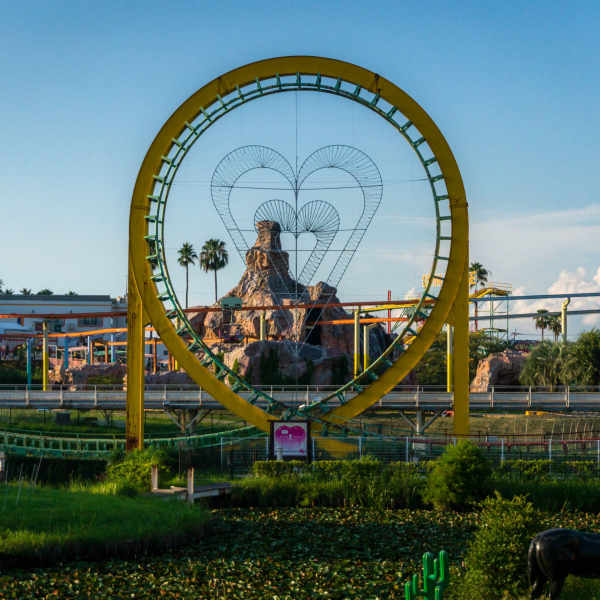
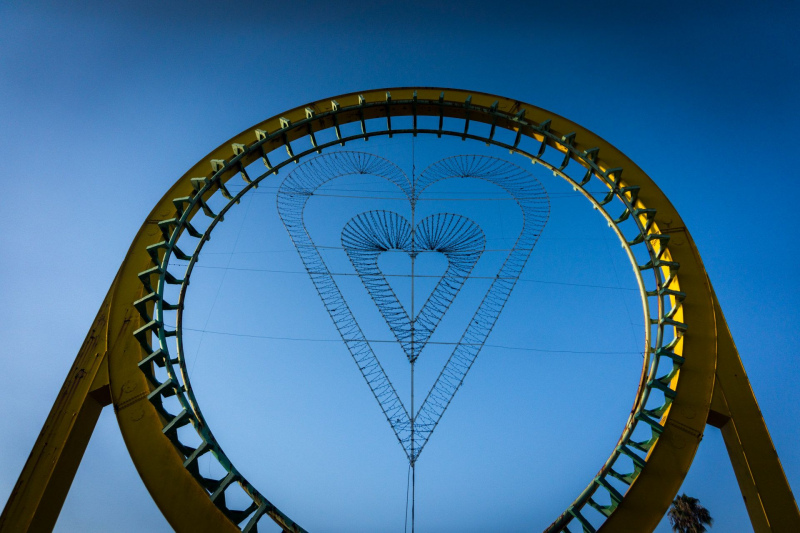
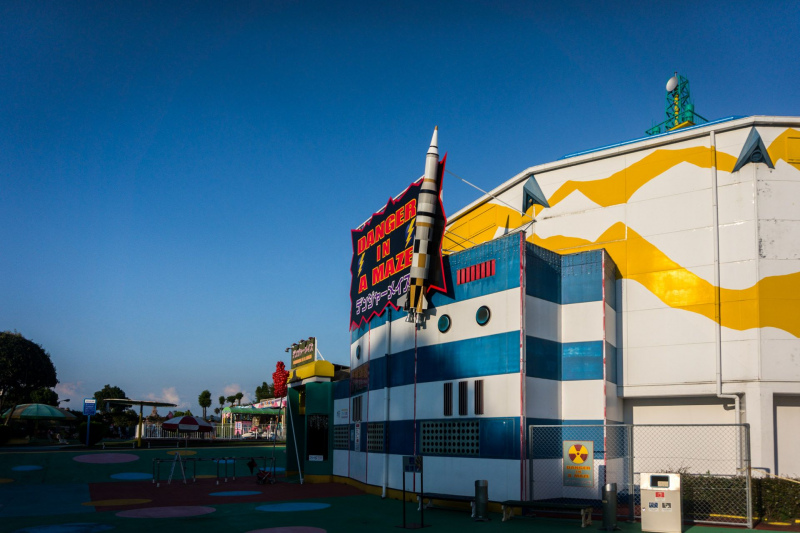
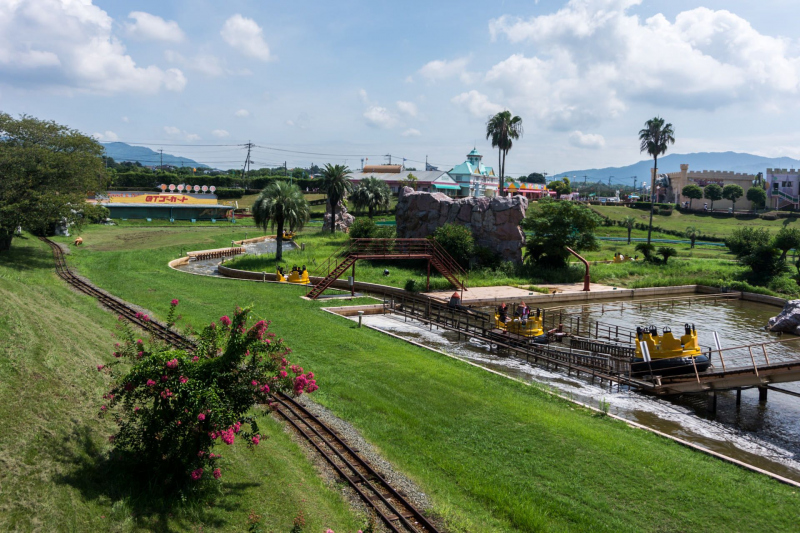
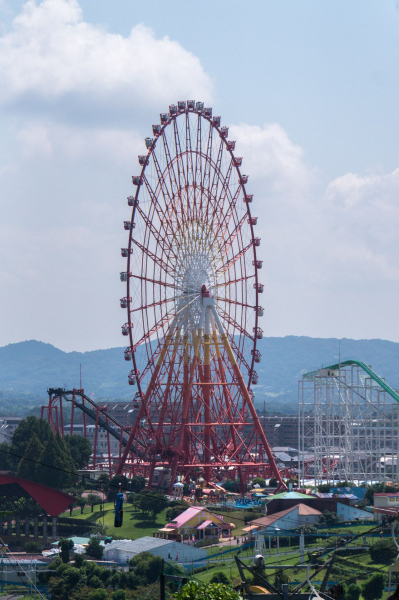
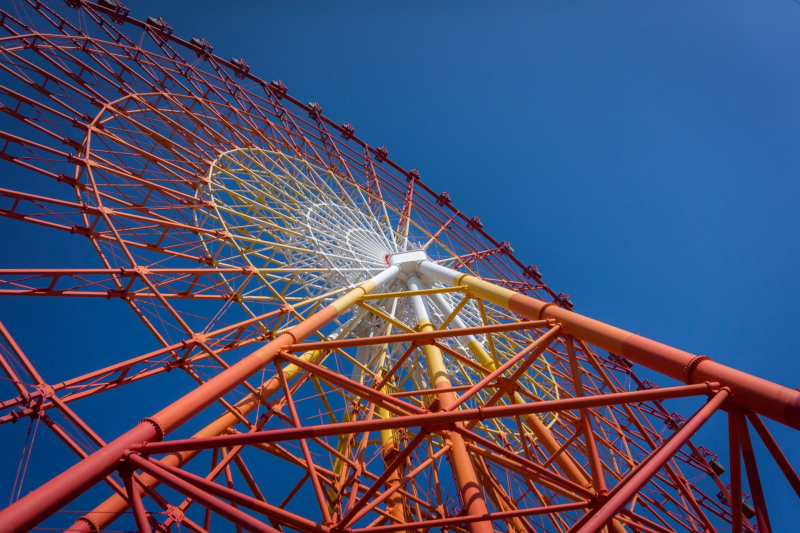
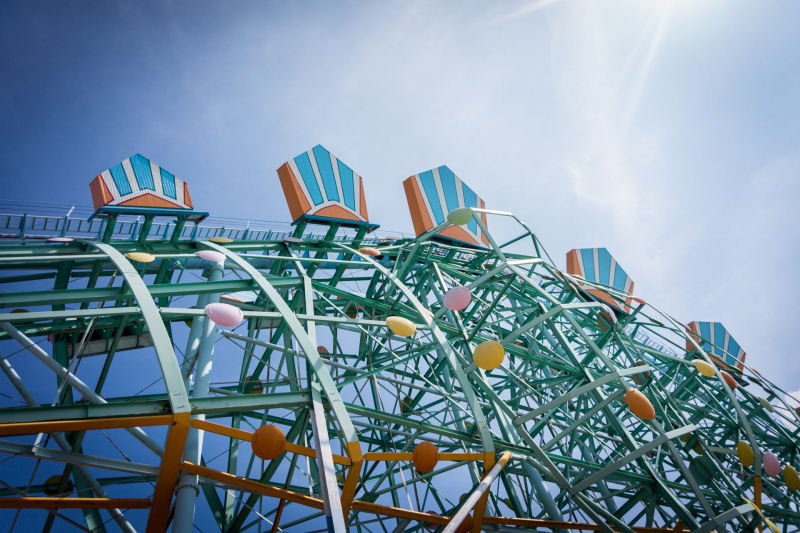
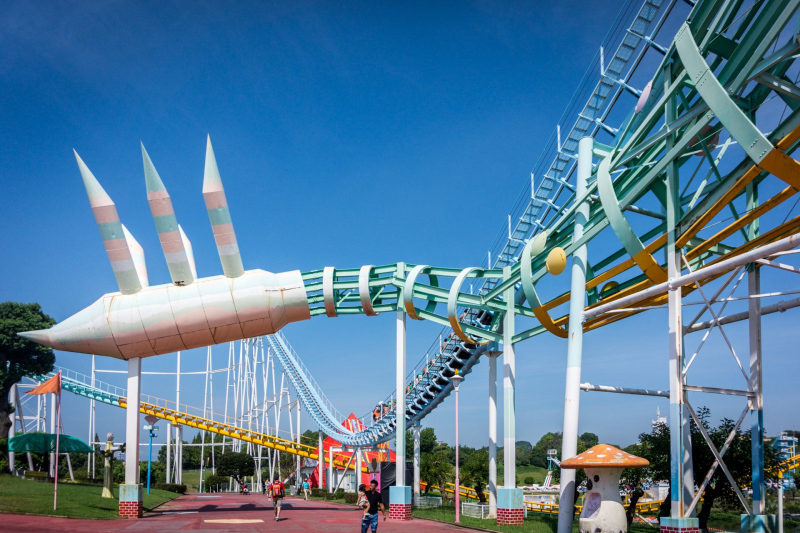
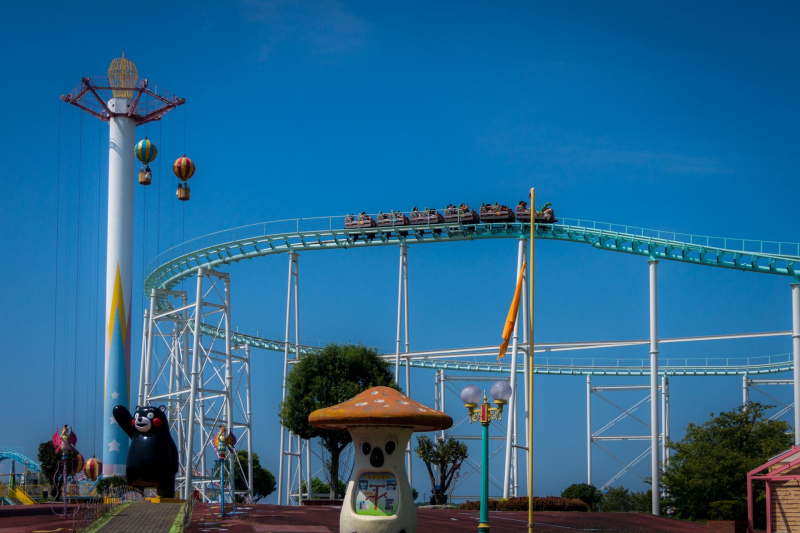
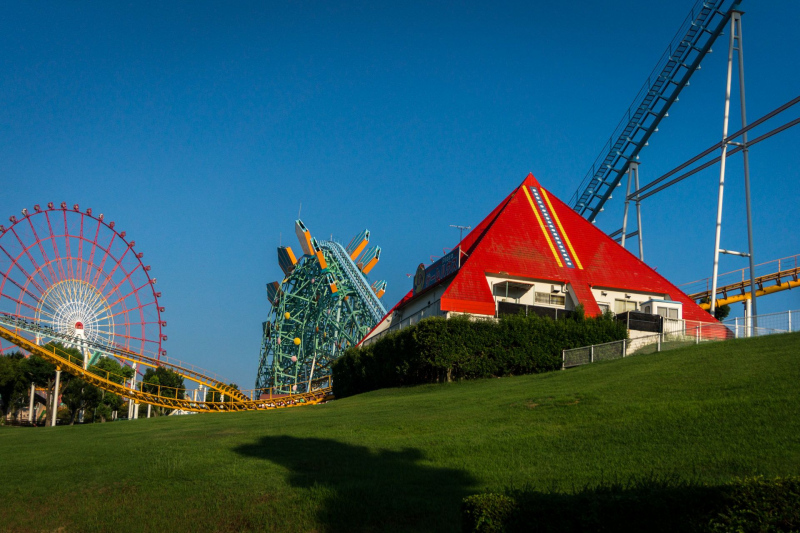
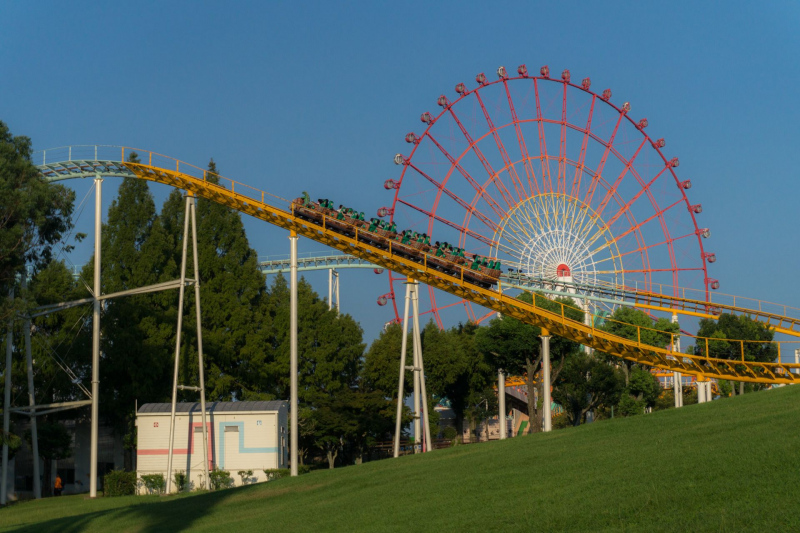
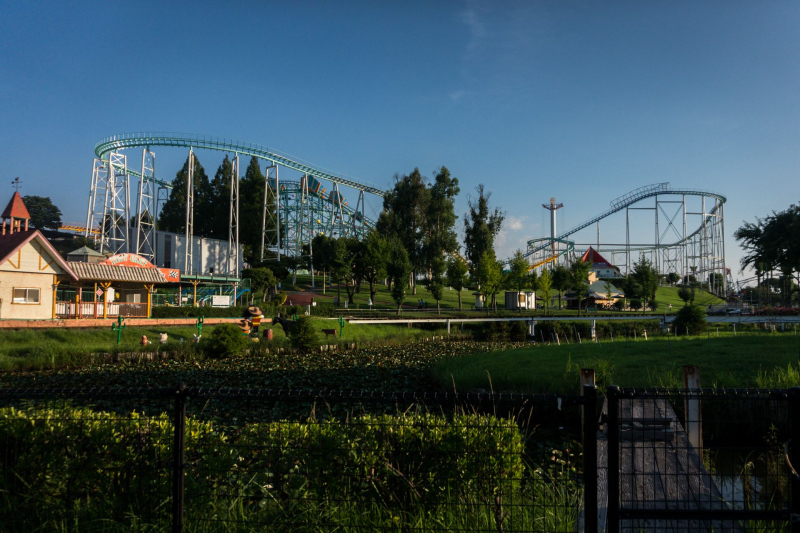
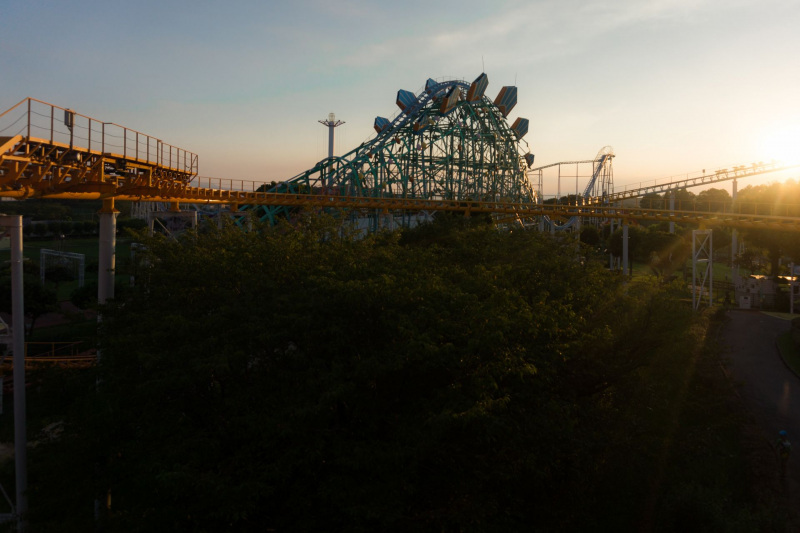
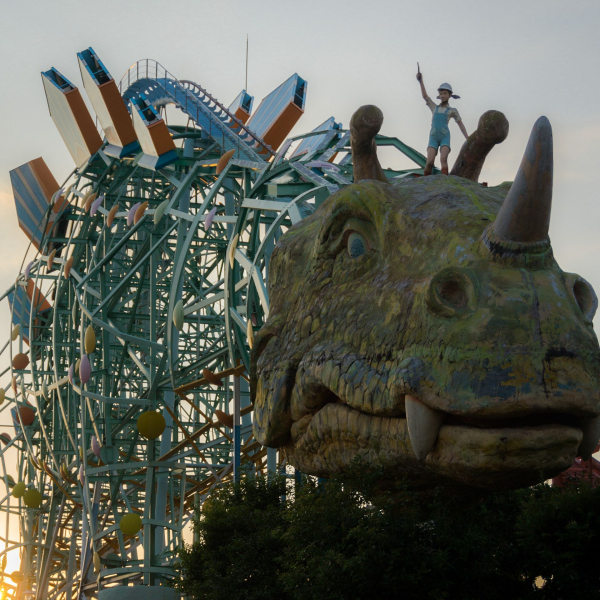
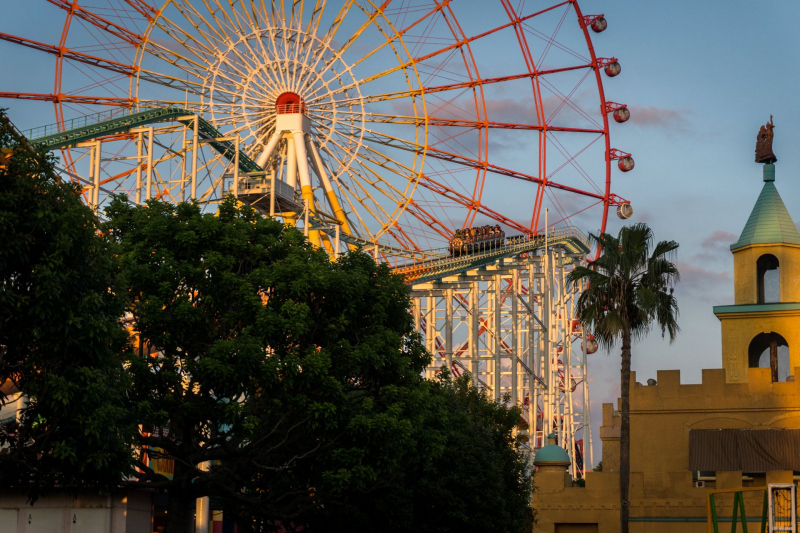
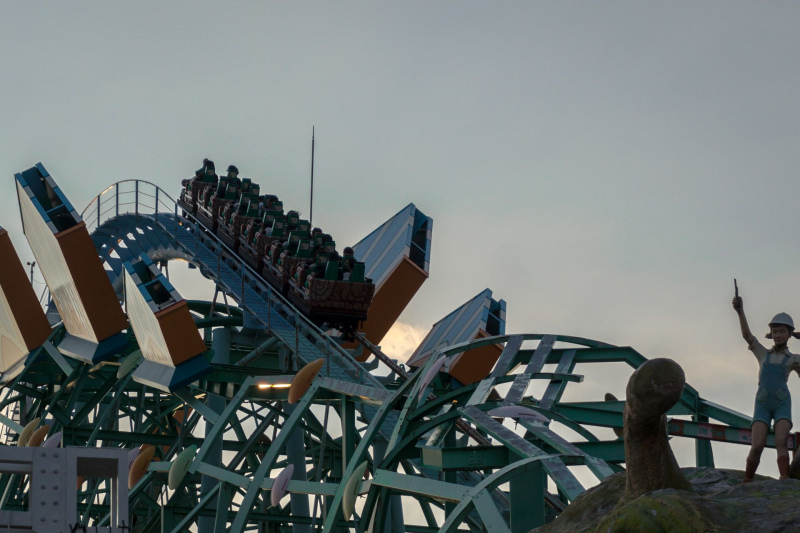
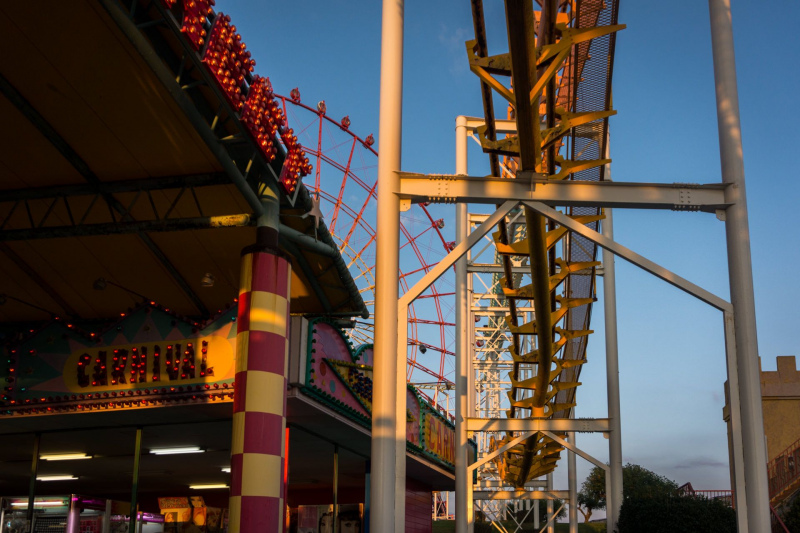
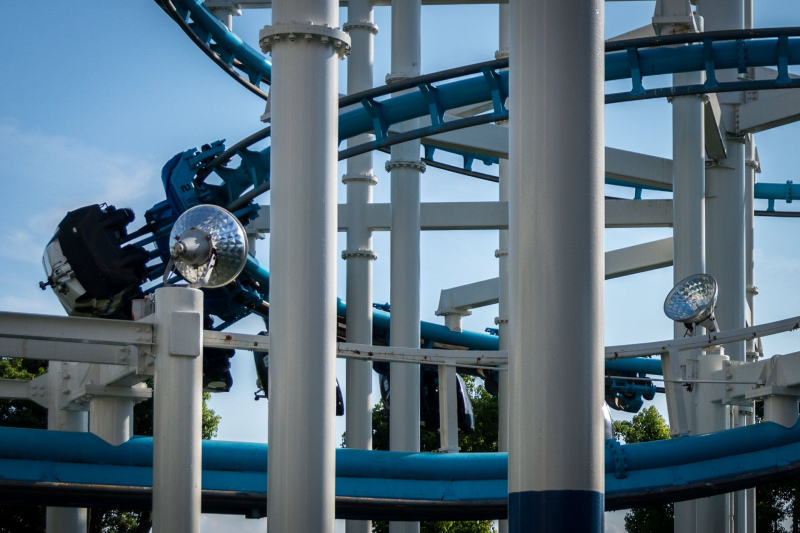
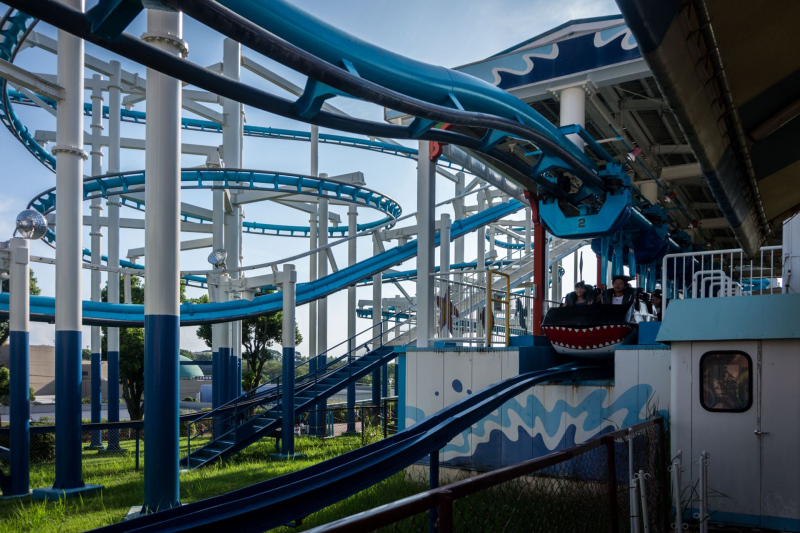
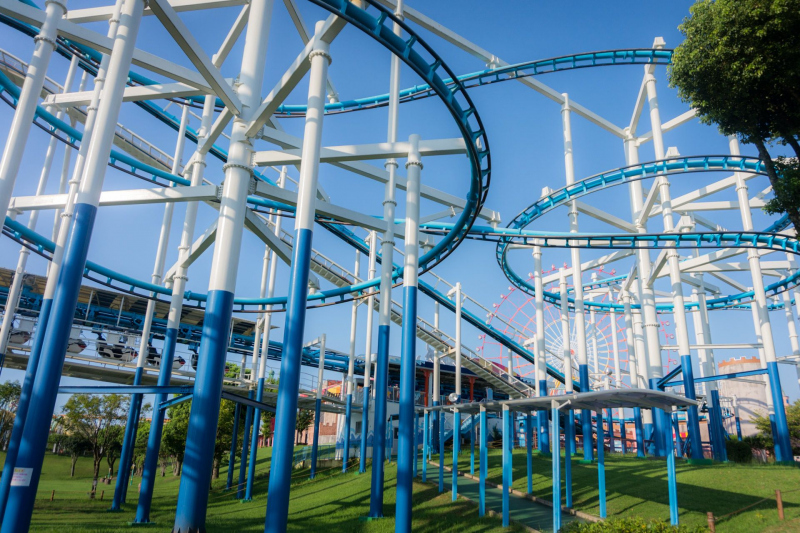
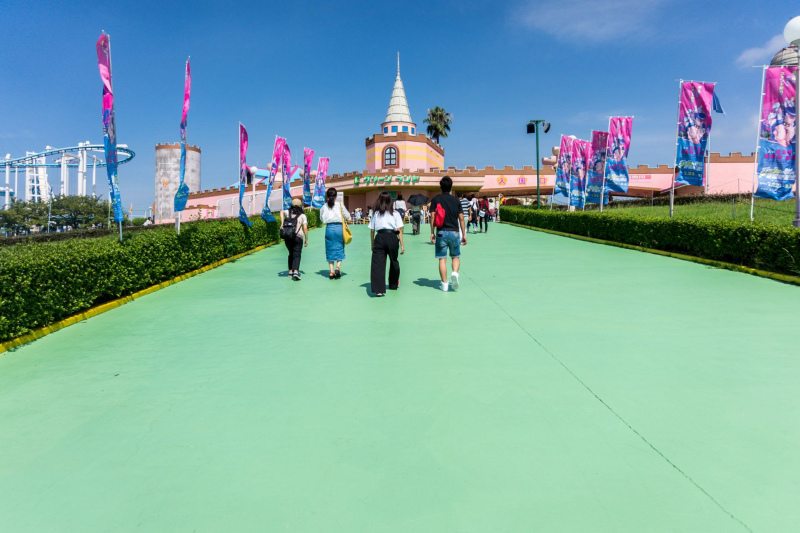
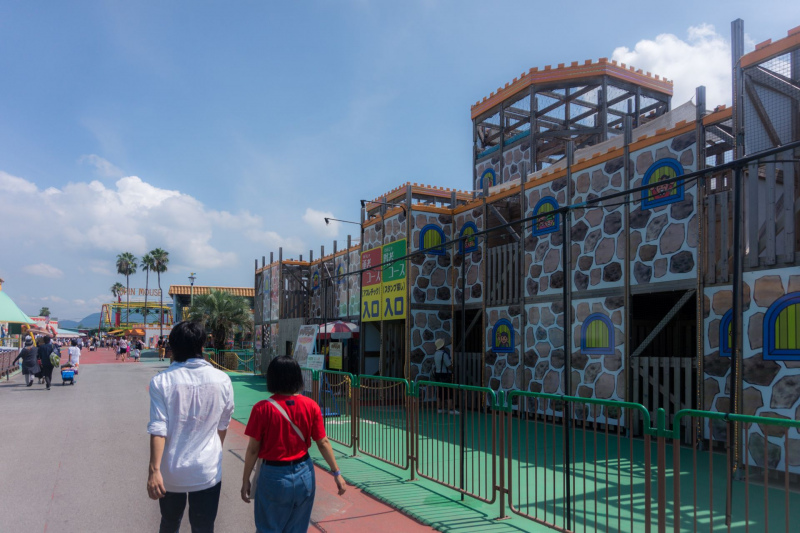
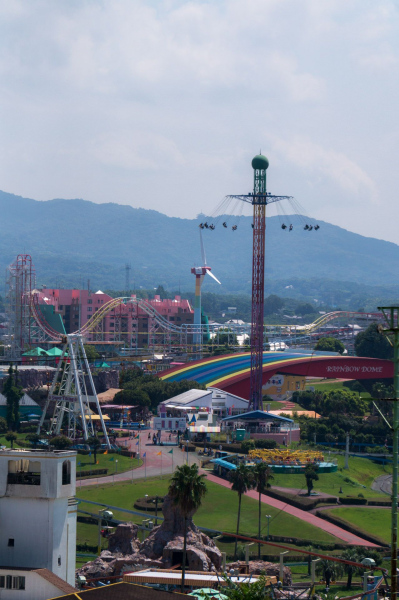
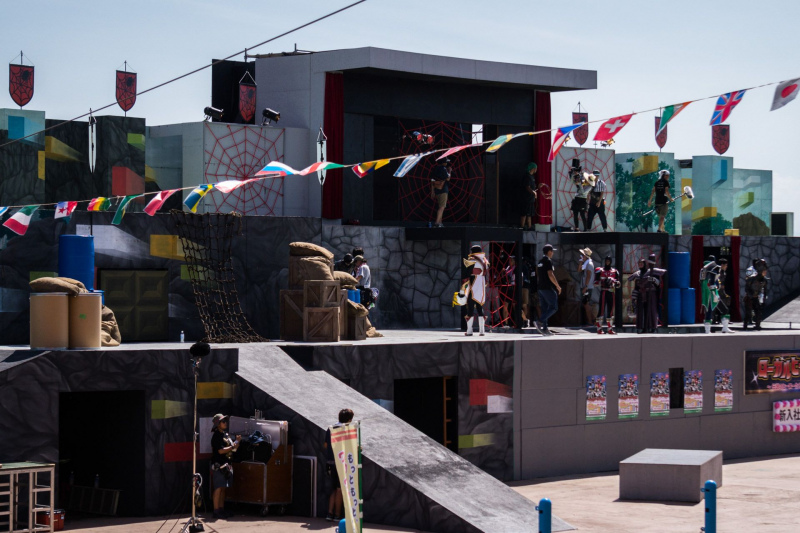
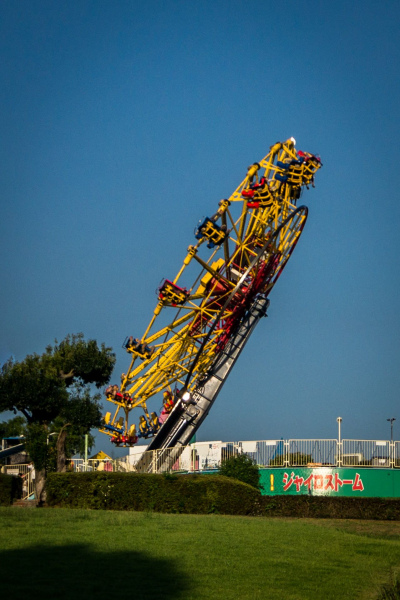
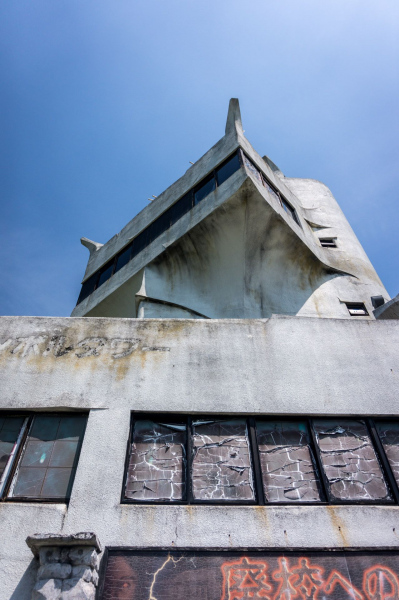
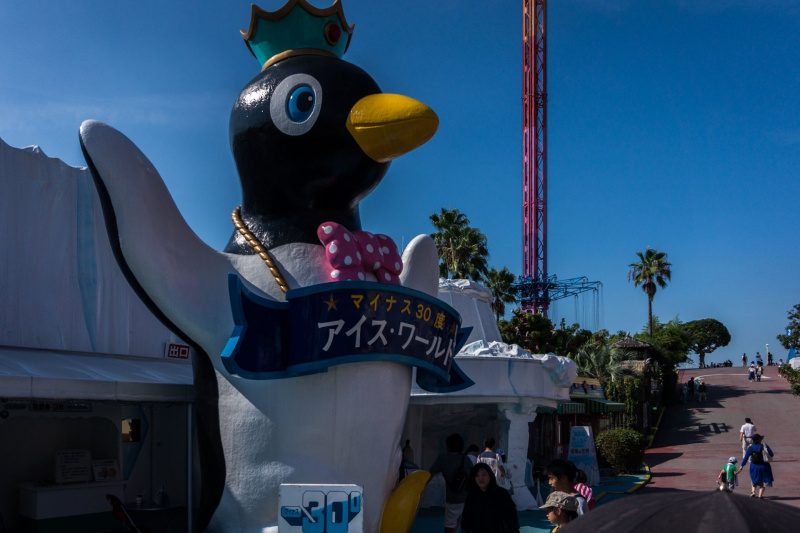
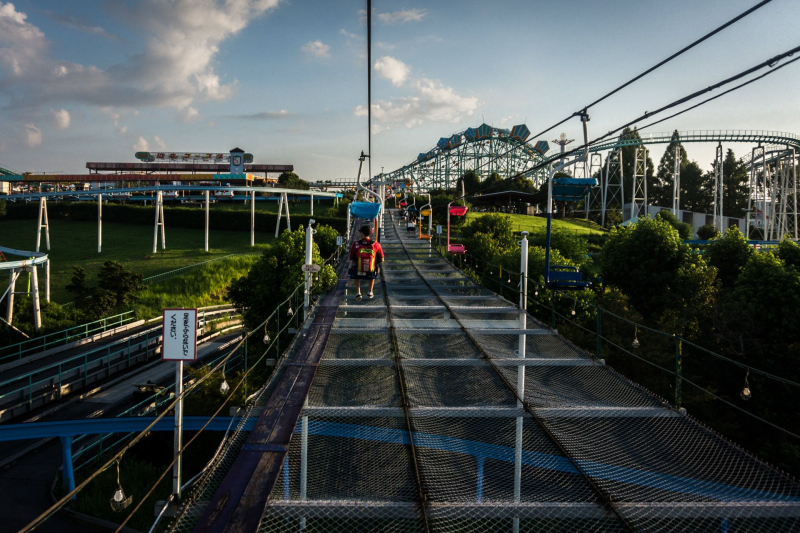
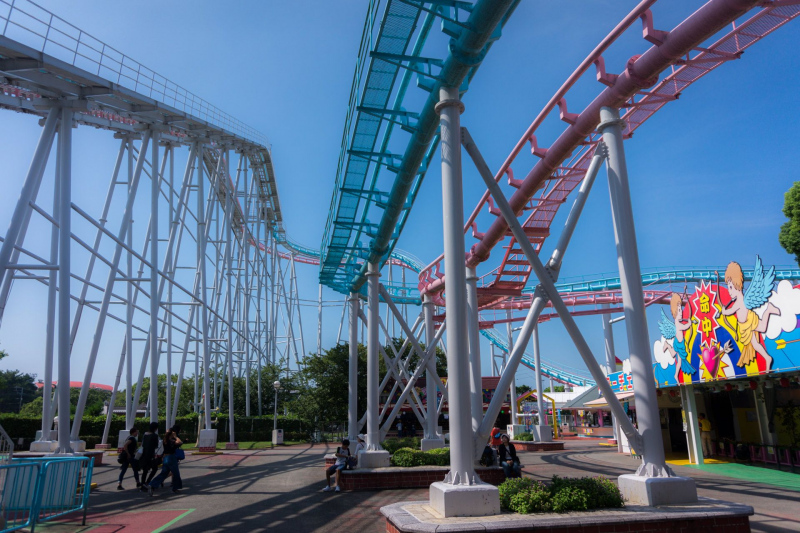
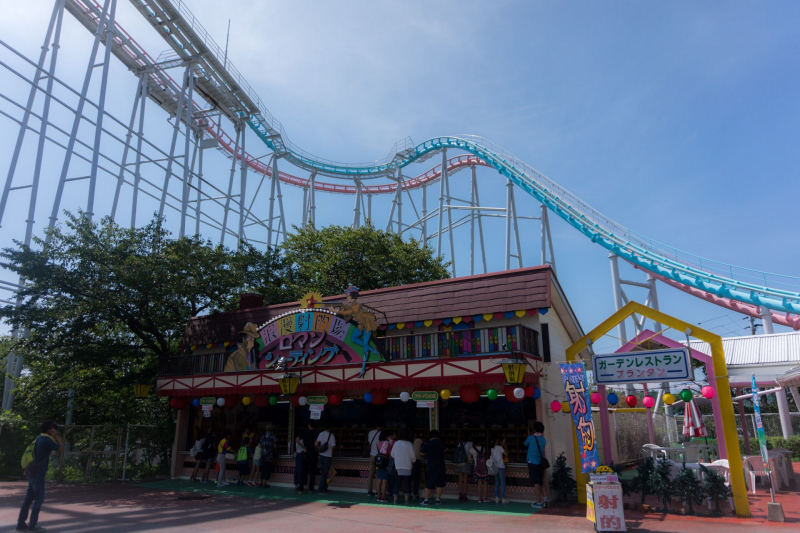
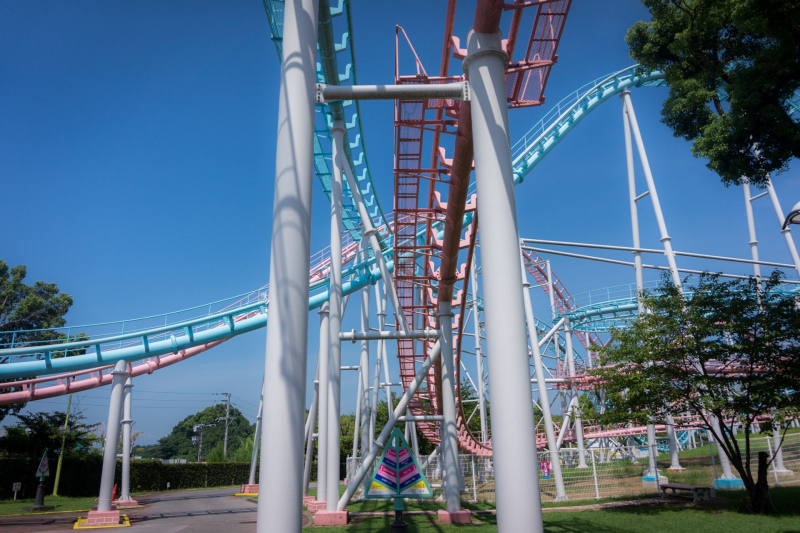
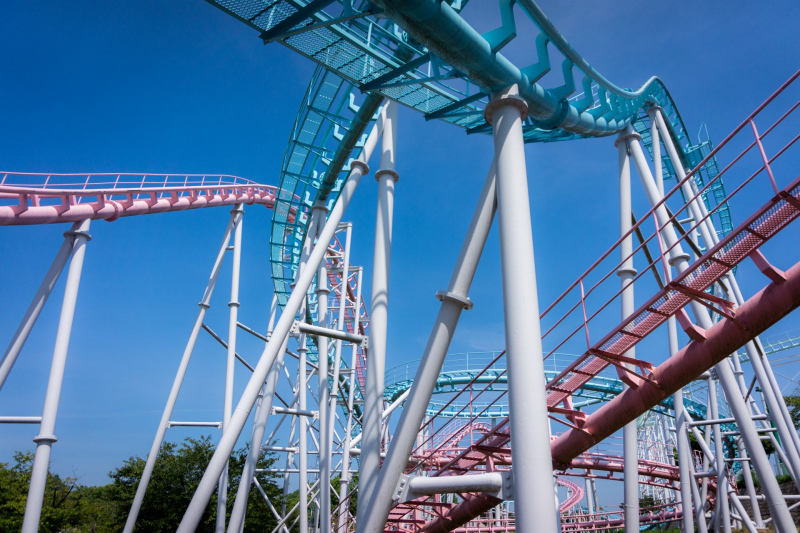
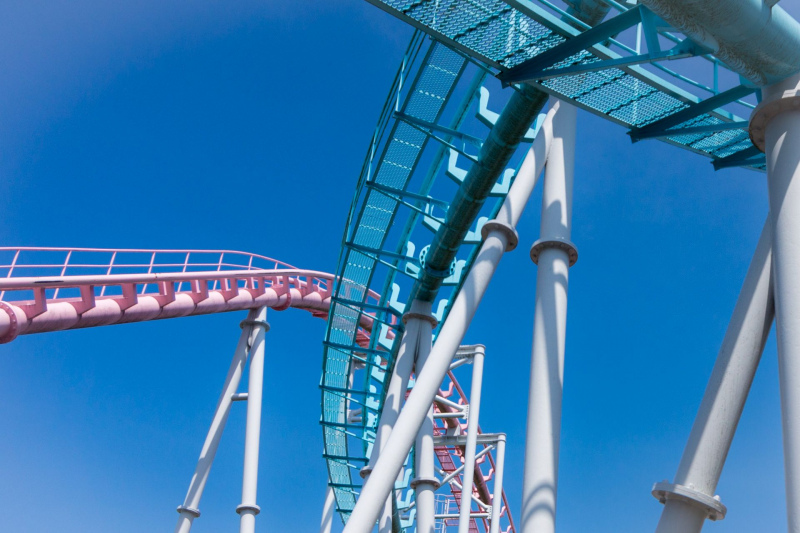
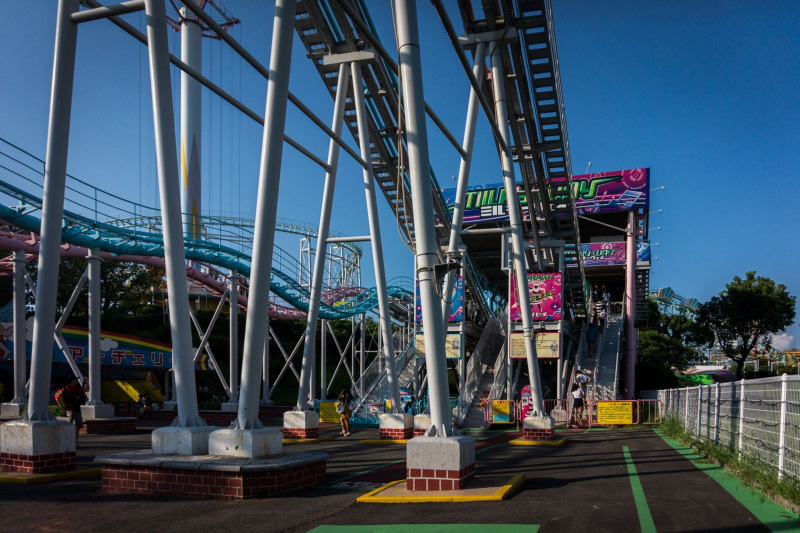
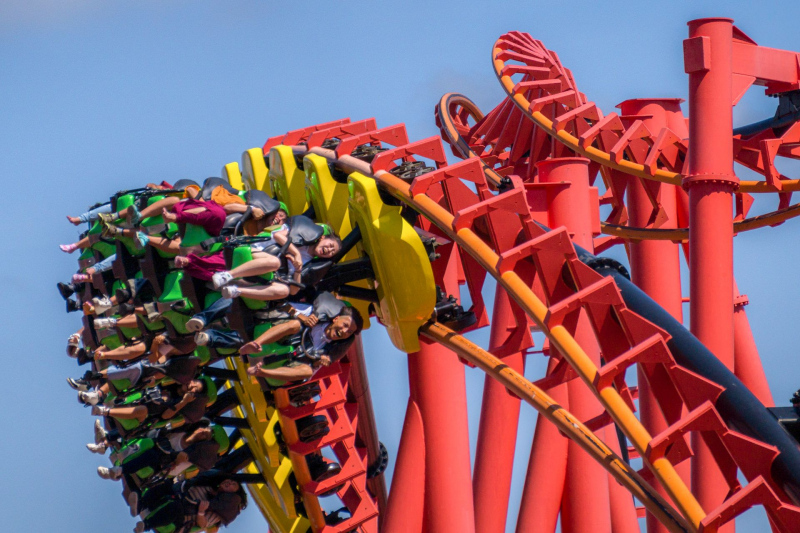
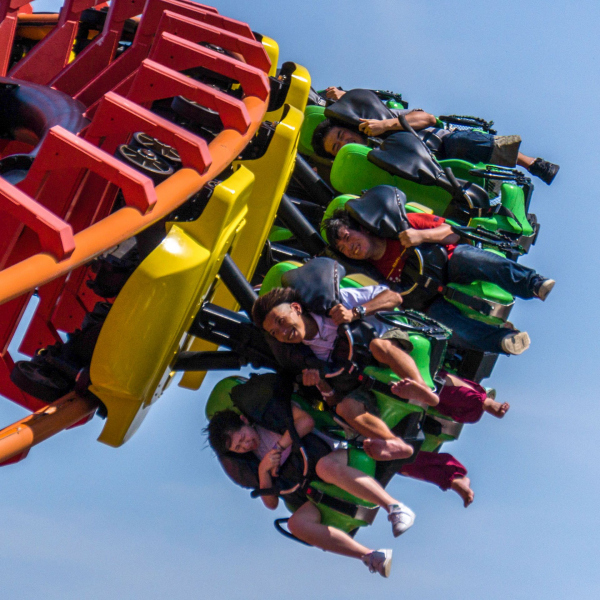
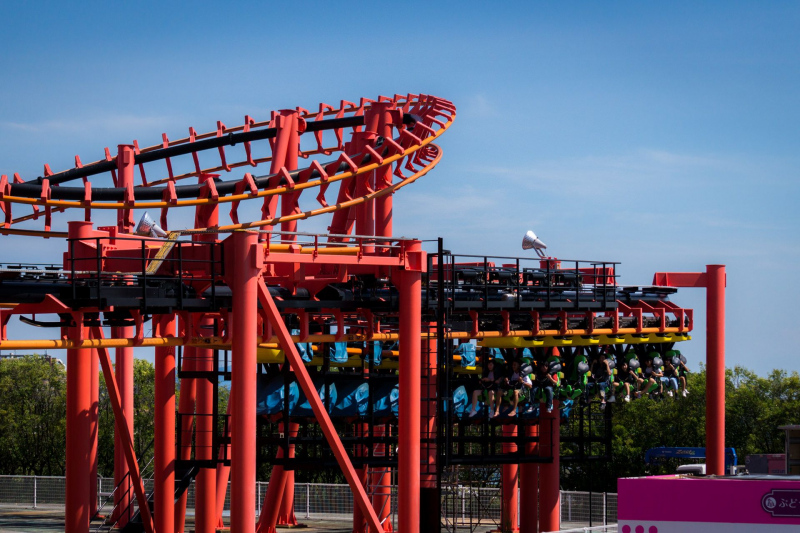
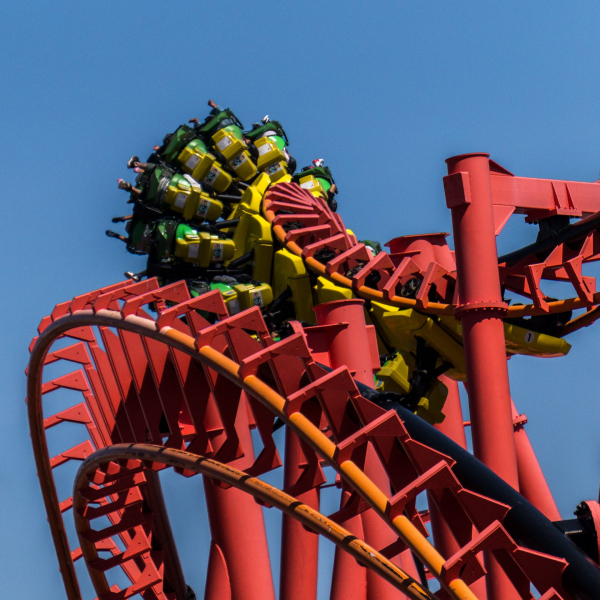
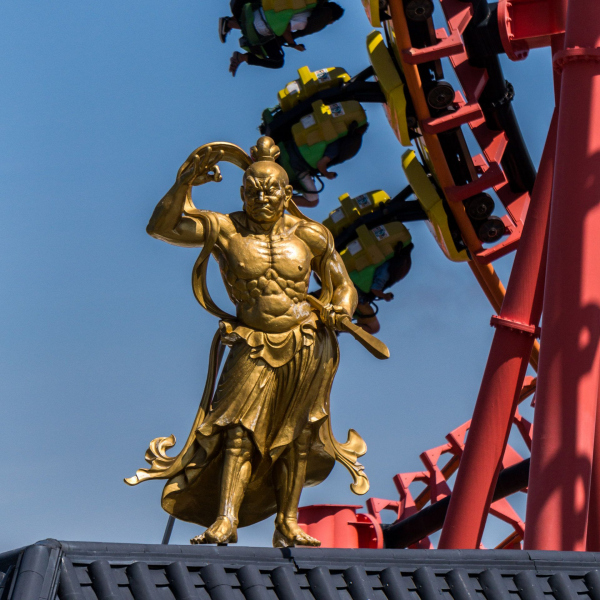
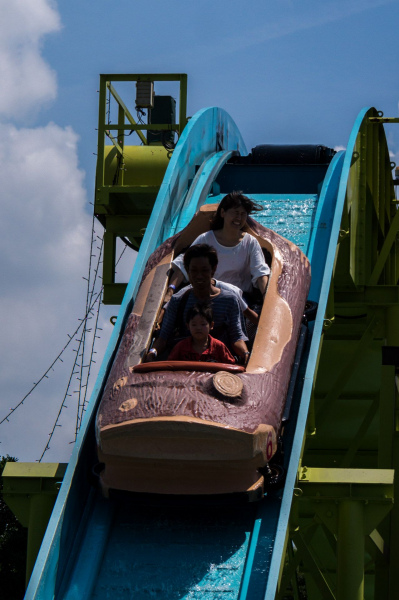
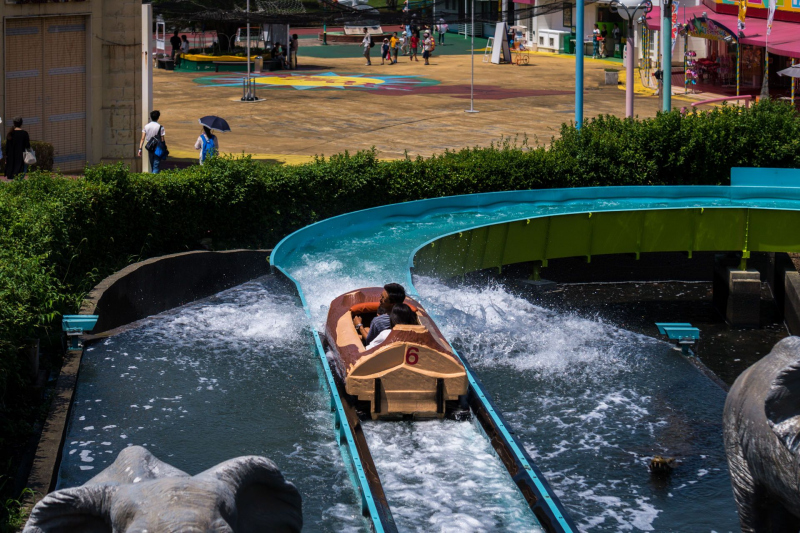
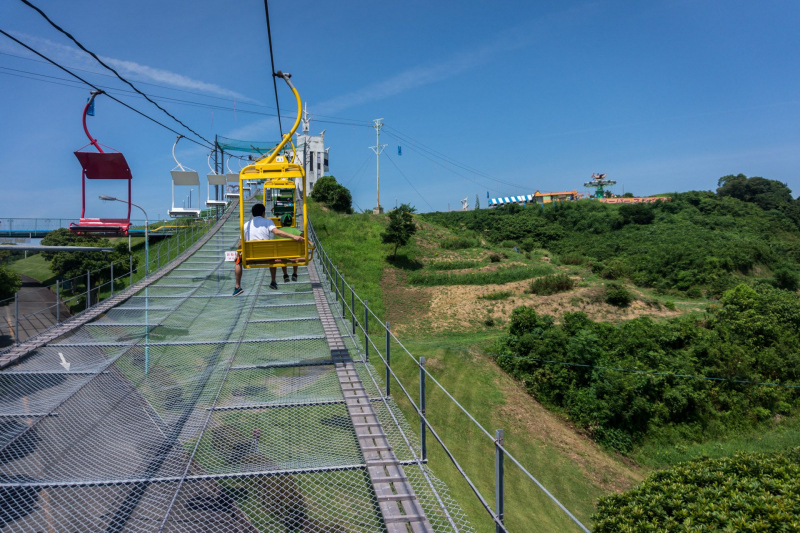
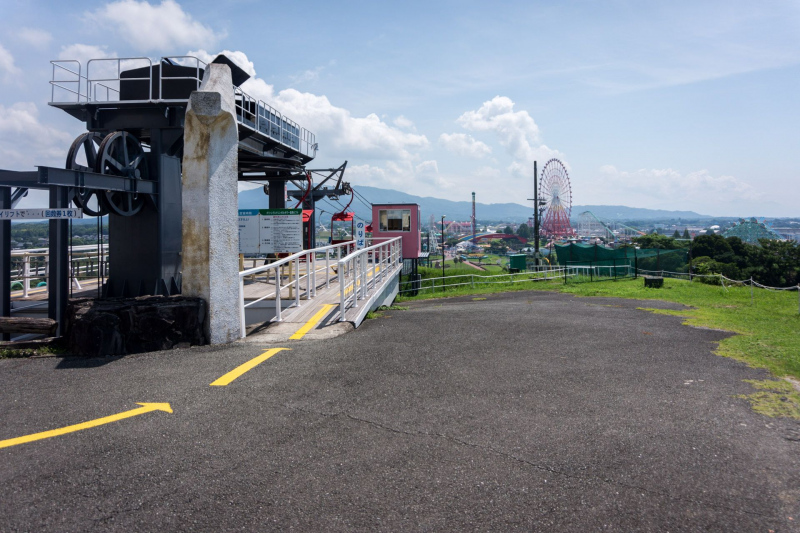
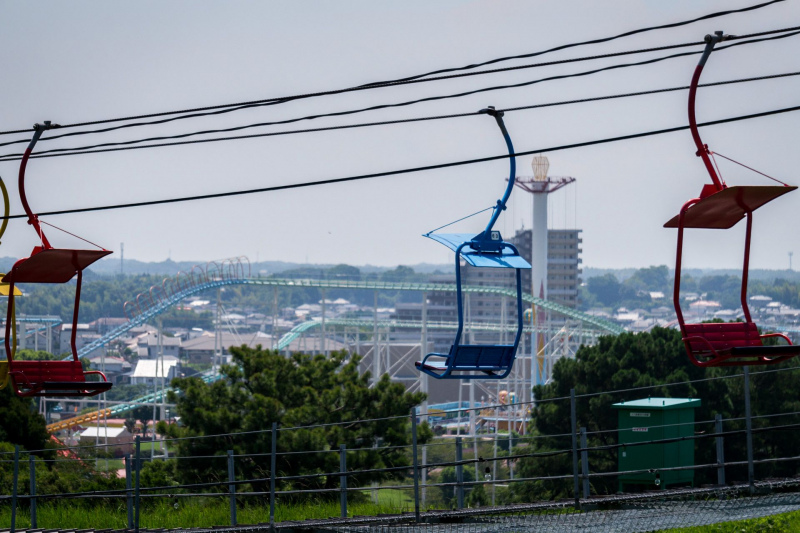
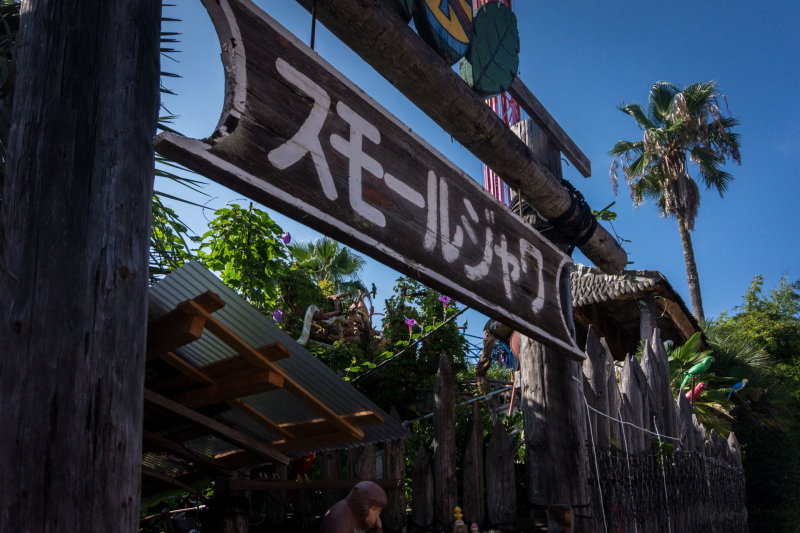
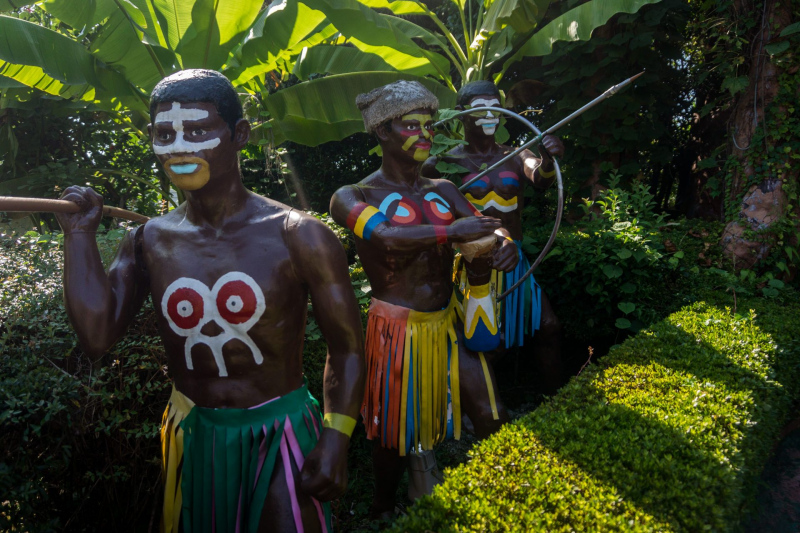
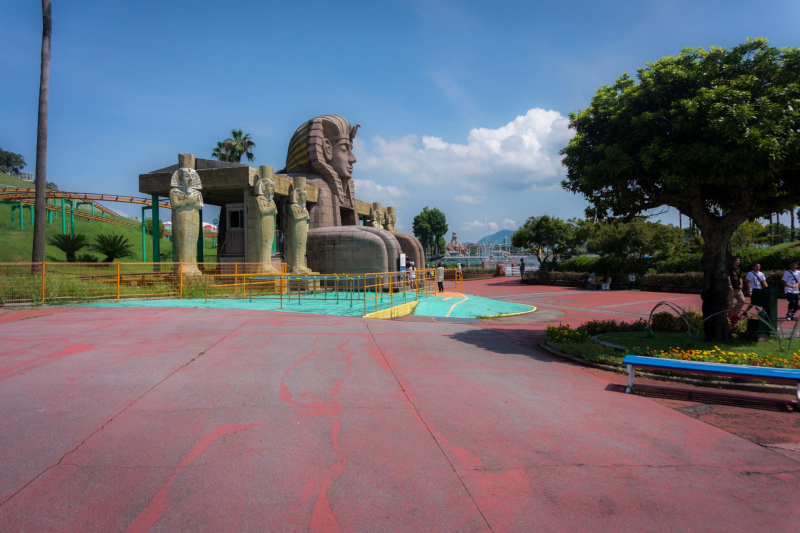
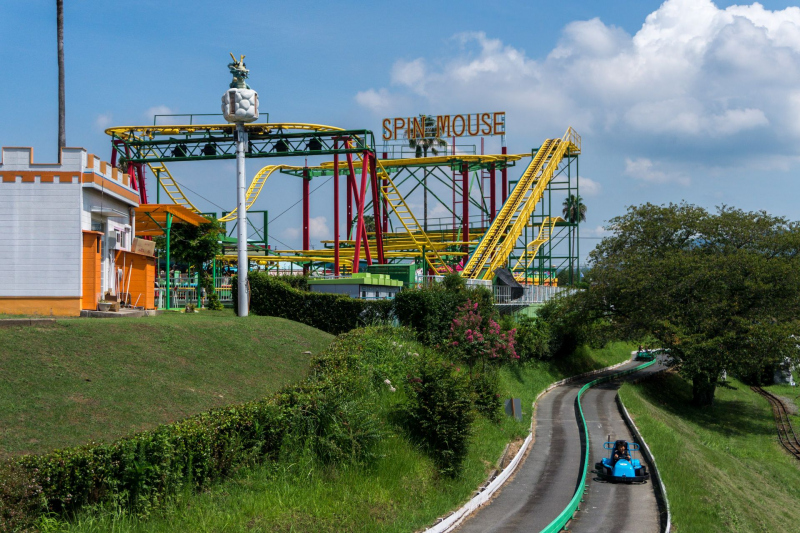
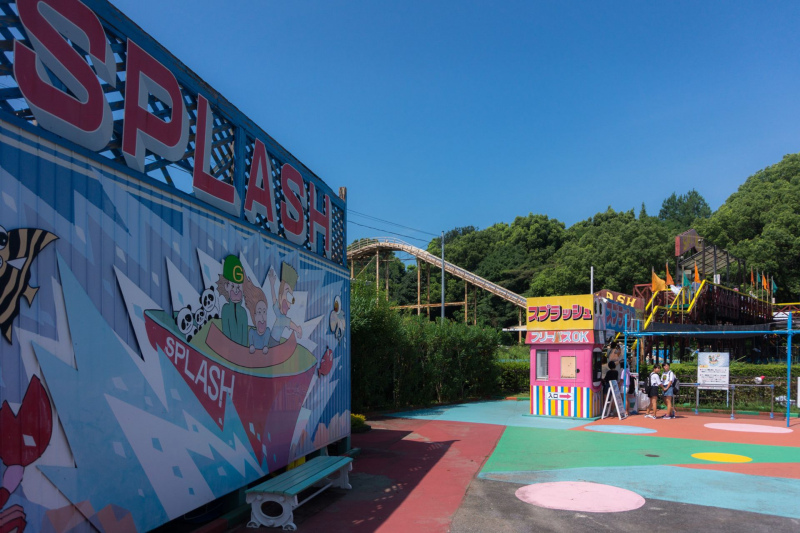
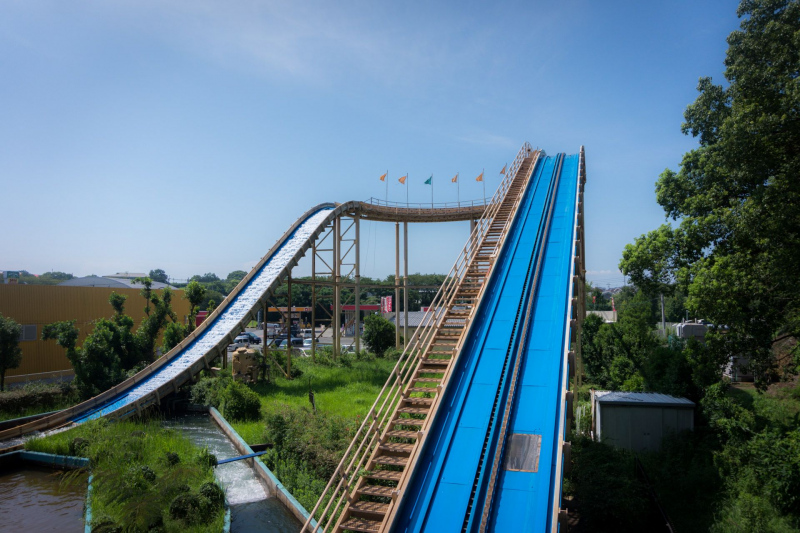
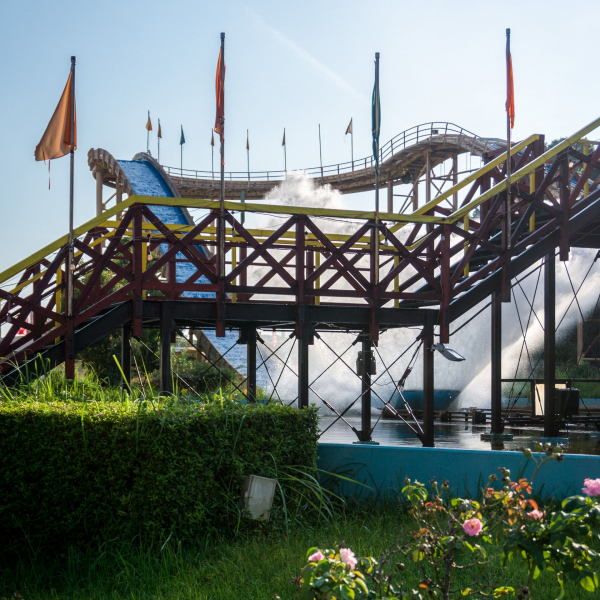
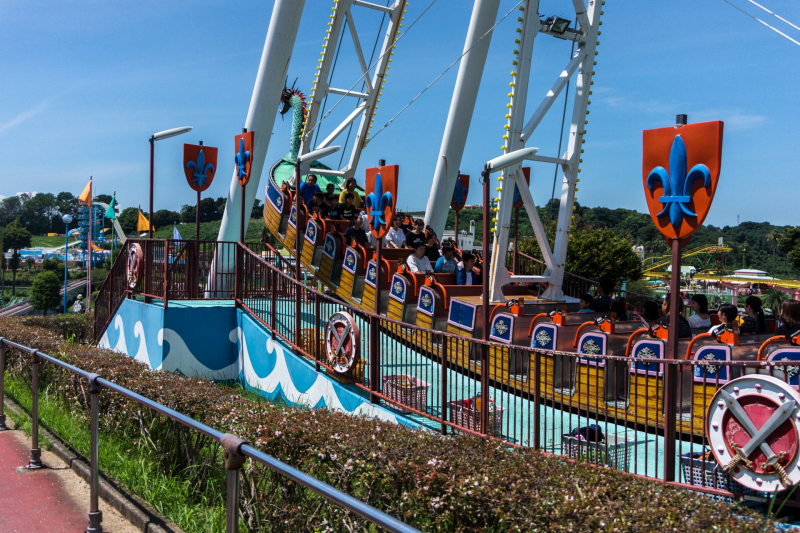
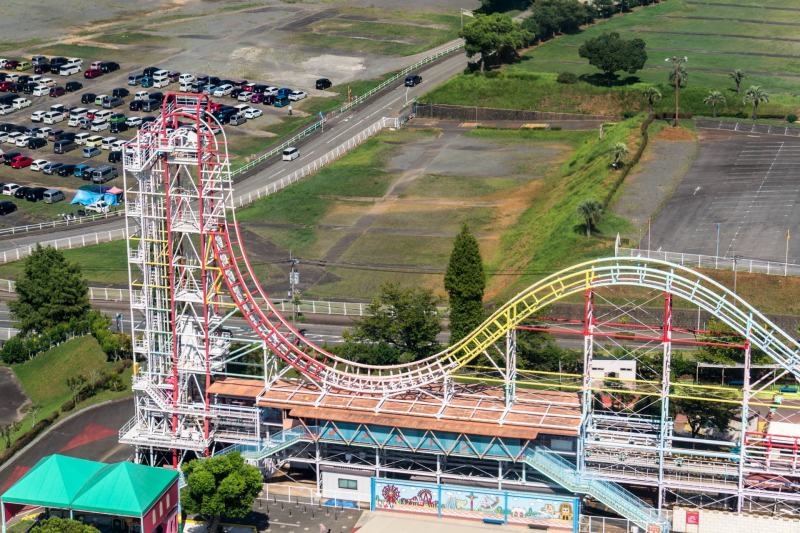
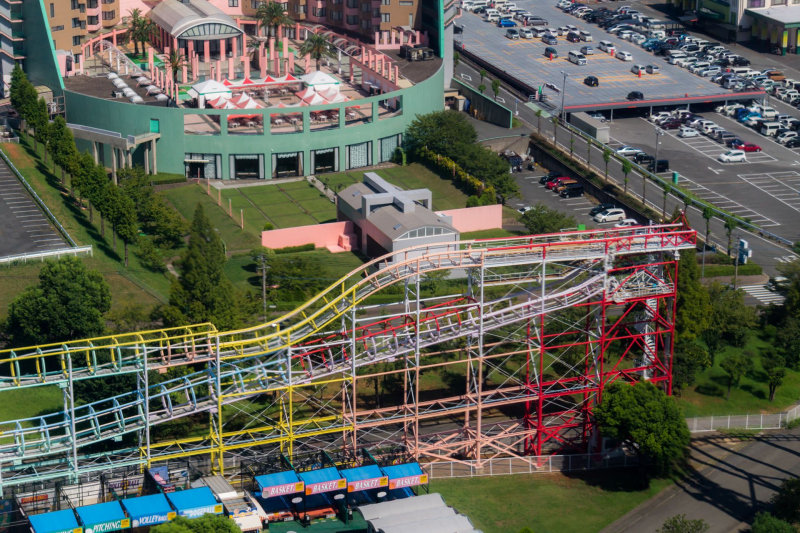
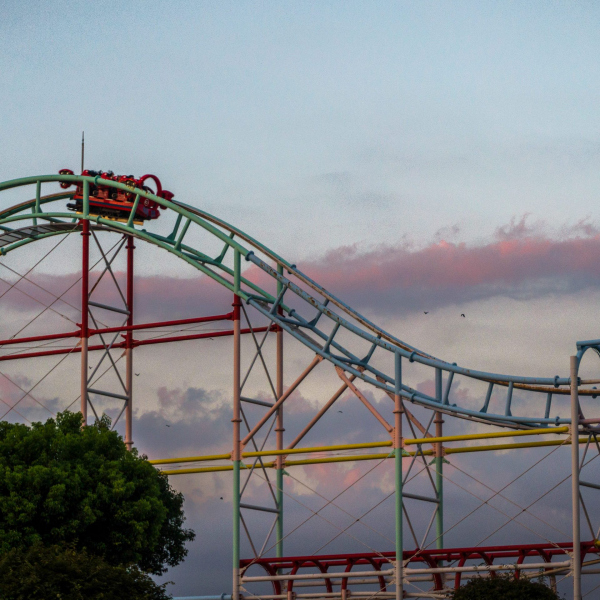
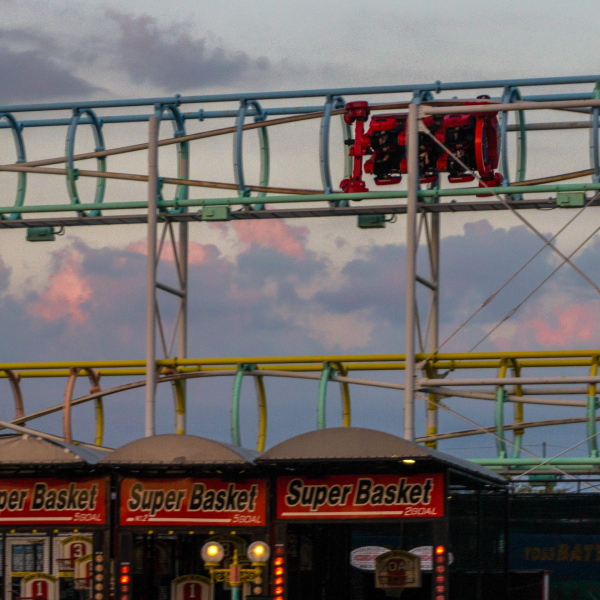
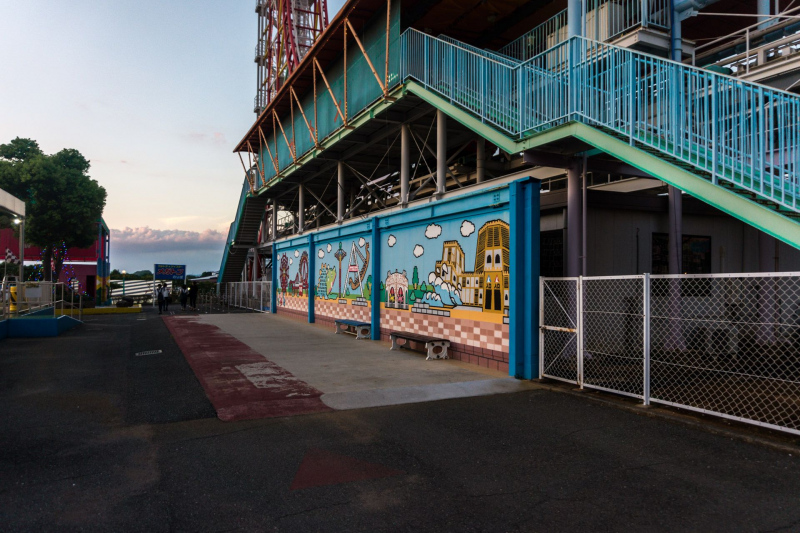
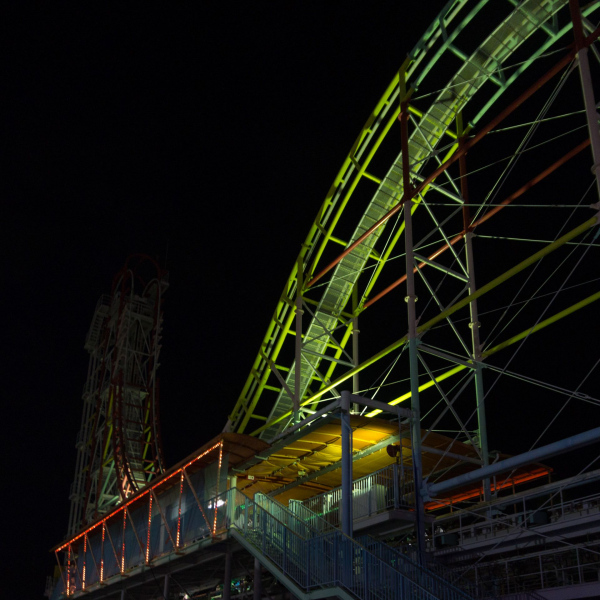
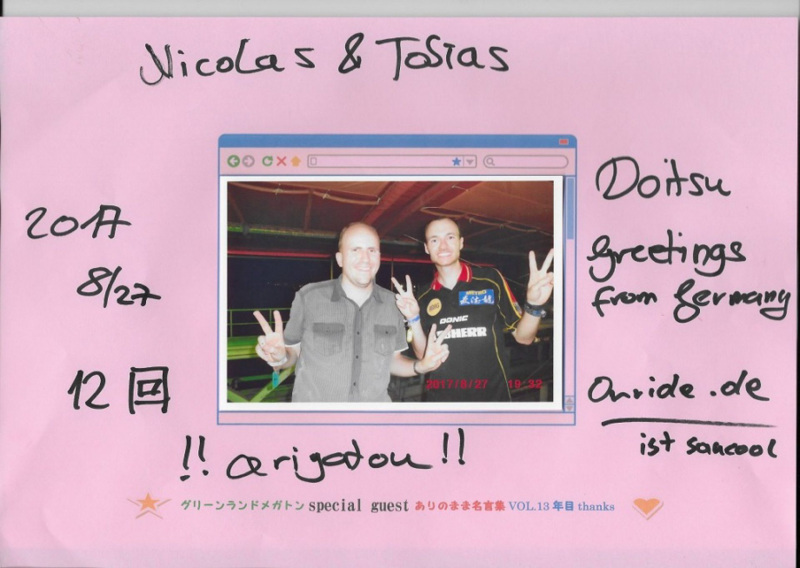

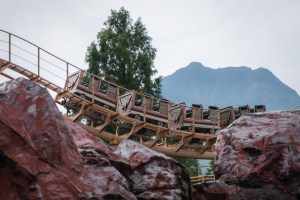
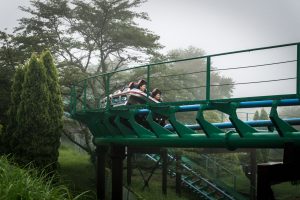 Fun Fact #1:
Fun Fact #1: